- Frank Magazine
- Denison History
- Virtual Tours
- Alaskan Yachts
- Azimut Yachts
- Back Cove Yachts
- Beneteau Yachts
- Benetti Superyachts
- Bertram Yachts
- Boston Whaler
- Broward Yachts
- Buddy Davis Sportfish
- Burger Yachts
- Cabo Yachts
- Carver Motoryachts
- Center Console
- Chris-Craft Yachts
- Cruisers Yachts
- DeFever Trawlers
- Dufour Sailboats
- Fairline Yachts
- Feadship Yachts
- Ferretti Yachts
- Formula Yachts
- Fountaine Pajot Cats
- Grady-White
- Grand Banks Trawlers
- Hargrave Yachts
- Hatteras Yachts
- Hinckley Picnic Boats
- Horizon Yachts
- Hydra-Sports
- Intrepid Boats
- Jarrett Bay Sportfish
- Jeanneau Yachts
- Kadey-Krogen Trawlers
- Lazzara Yachts
- Luhrs Sportfish
- Marlow Yachts
- Maritimo Yachts
- Marquis Yachts
- McKinna Motoryachts
- Meridian Yachts
- Midnight Express
- Mochi Craft
- Neptunus Motoryachts
- Nordhavn Trawlers
- Nordic Tugs
- Ocean Alexander Yachts
- Offshore Yachts
- Oyster Sailing Yachts
- Pacific Mariner Yachts
- Palmer Johnson Yachts
- Pershing Yachts
- Prestige Yachts
- Princess Yachts
- Pursuit Yachts
- Riva Yachts
- Riviera Yachts
- Sabre Downeast
- San Lorenzo Yachts
- Sea Ray Boats
- SeaVee Central Consoles
- Selene Trawlers
- Scout Yachts
- Sunseeker Yachts
- Tiara Yachts
- Trinity Superyachts
- Viking Yachts
- Westport Yachts

OCEAN WARRIOR Boat for Sale
39' pelin | 1993 | $285,000.
- Yachts for sale
- unspecified
Ocean Warrior
Last updated Feb 5, 2024
Ocean Warrior Yacht | 39' Pelin 1993
If you are looking for a go-anywhere, strong cruising vessel set up for two, look no further! Easily operated by one with twin helms, generous walk-around decks and helm door.
With Ocean Warriors iconic, frugal and economical Gardner diesel and a fuel capacity of 2,500 litres, she is designed to meet the demands of fishing, diving, and reaching those distant spots and has been engineered with durability and safety in mind.
Featuring a massive cockpit area with massive storage beneath, you'll have no shortage of room to load all your fishing and diving gear with a pot hauler cleverly stowed away. 980 watts of solar power ensures that you have heaps of electrical power, a diesel stove ensures the boat is warm and toasty even in the height of a Fiordland winter. The on-board inventory is huge and includes a Zodiac inflatable with outboard, a liferaft, a game chair, a drum winch, underwater lights.....and the list goes on!
Offering an impressive arsenal of electronics and unmatched practicality, this vessel is ready to take you outdoors on your next adventure virtually anywhere. This would be an ideal vessel for syndication based in Fiordland.
Get in touch with us at 36° Brokers today to organise a viewing and see her for yourself!
Call Jan on +64 27 8140 733 or Gordon on +64 21 321 820 to arrange a viewing, you will not be disappointed!
Denison Yachting is pleased to assist you in the purchase of this vessel. This boat is centrally listed by 36 Degrees.
Denison Yacht Sales offers the details of this yacht in good faith but can’t guarantee the accuracy of this information nor warrant the condition of this boat for sale. This yacht for sale is offered subject to prior sale, price change, or withdrawal from that yacht market without notice. She is offered as a convenience by this yacht broker to its clients and is not intended to convey direct representation of a specific yacht for sale.
INQUIRE ABOUT OCEAN WARRIOR
Have questions about this yacht? Fill out the form below and our team of experts will contact you soon.
Your privacy is important to us. Find out how we protect it. Privacy Policy

First-Time Buyer?
Read our guide to learn the process for buying OCEAN WARRIOR
Ocean Warrior HIGHLIGHTS
- Yacht Details: 39' Pelin 1993
- Location: Picton,
- Engines: Gardner
- Last Updated: Feb 5, 2024
- Asking Price: $285,000
- Maximum Speed: 10 kn
- Max Draft: 5' 11''
Ocean Warrior additional information
- Cruising Speed: 6.5 kn
- Beam: 16'
- Hull Material: Steel
- Displacement: 35,273.96 lb
- Fuel Tank: 1 x 2500|liter
- Fresh Water: 1 x 1250|liter
- Single Berths: 4
Schedule a Tour of OCEAN WARRIOR
Contact our team to schedule a private showing.
SIMILAR YACHTS FOR SALE View All
137' nigel irens 2009, bintan island, indonesia, 112' mangusta 2005, milano, it-mi, italy, lynx yxt 34m, 111' lynx 2024, nijkerk, netherlands, sea coral ii, 105' arcadia yachts 2019, golfe juan, 06, france, lady maïa, 105' baglietto 2004, dubaï, united arab emirates, 95' explorer 2005, interyachts, 94' de vries lentsch 1984, monaco, greece, other pelin yachts for sale view all, 39' pelin 1993, related services.

LOGIN OR REGISTER
Hi, welcome back.
Login and pick up from where you left off.
Creating an account allows you to save and compare your favorite yachts.
By creating an account you agree to the terms of use and our privacy policy.
Sea Shepherd Launches New Anti-Poaching Boat 'Ocean Warrior'
"Poachers beware; here she comes."
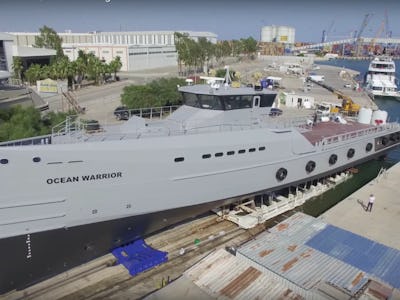
Sea Shepherd’s brand new anti-poaching boat slowly moved into the Antalya Harbour in Turkey on Friday, touching its first saltwater in what is sure to be a long career of cruising the world’s oceans. The MV Ocean Warrior is the conservation group’s first custom-built vessel , designed to chase down and stomp out illegal fishing.
“Poachers beware; here she comes,” Sea Shepherd Captain Alex Cornelissen says as the Ocean Warrior slowly leaves the shipyard, carried by heavy machinery. At 175 feet long, the boat is a sight to behold. She is the fastest boat in the Sea Shepherd fleet, and designed especially for the harsh conditions of Antarctic waters. The deck is large enough to launch smaller boats and helicopters.
The Ocean Warrior has its sights set on the Japanese fishing fleet that periodically takes whales from the Antarctic Ocean, ostensibly for scientific research, even following a ruling of the International Court of Justice outlawing the hunt. In previous years, Sea Shepherd has successfully interfered with the ability of the Japanese boats to kill whales and take them on board. And last year, the poachers won as Sea Shepherd could not determine their location and did not have the resources to scour an enormous ocean to find them.
“This new ship is a game-changer,” Adam Burling with Sea Shepherd Australia previously told Inverse . Not only will the Ocean Warrior ’s speed improve odds of finding illegal fishing vessels, it will help to stay on their tails, too. Sea Shepherd’s other ships are not fast enough to keep up with the Japanese harpoon ships that do the actual hunting; instead, the tactic in the past has been to stay with the larger factory ship and try to prevent whales from moving between the two. This new ship may prevent more whales from dying in the first place, rather than using the dead ones to protect the living.
The plan is for the Ocean Warrior to tour the Netherlands and Australia before launching on its first official mission in September. Though the details have yet to be announced, Sea Shepherd is fundraising for gas money — an impressive $275,000.
BoatNews.com
Sea Shepherd launches patrol boat Ocean Warrior
On July 1, 2016 Sea Shepherd introduced its new vessel to combat smugglers. The Ocean Warrior was launched the same day in Turkey. Find out how the ship was launched.
The 1st er july 2016, Sea Shepherd launched its new patrol vessel, the Ocean Warrior. This is the first time that the NGO, which fights for the conservation of marine flora and fauna, has had a boat specifically designed for the needs of missions, particularly in the Antarctic. Typically, Sea Shepherd used to transform old ships (coastguards, fishing boats) into marine defence tools .
With this new vessel, the Sea Shepherd team benefits from a ship capable of overtaking the harpoon ships of the Japanese whaling industry in terms of speed . It was made possible thanks to a donation of 8.3 million euros from the Dutch Postal Code Lottery, the People's Postcode Lottery in the United Kingdom and the Svenska Postkod Lotteriet in Sweden.
Built at the Turkish shipyard in Damen, the patrol boat was carefully launched under the eyes of the members of the NGO's management. Installed on a trolley, it was conveyed to a hold before finally touching the water.
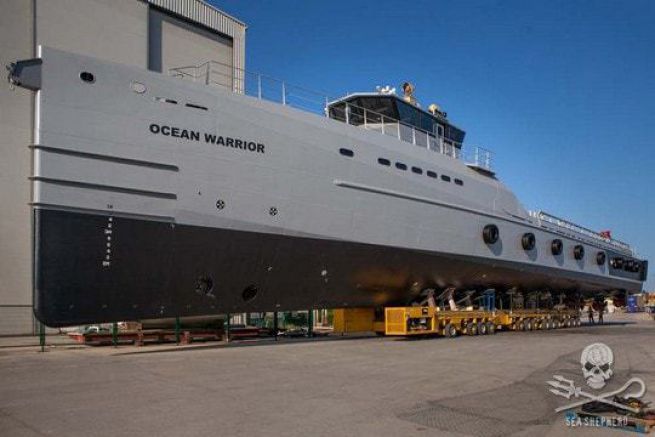
- Our Campaigns
Get Involved
Popular Searches
- IUU fishing
The Sea Shepherd Global Fleet
Neptune’s navy serves to protect and defend the world’s oceans and marine wildlife..
Since 1977, a number of vessels have served in the Sea Shepherd fleet to protect marine wildlife in direct-action campaigns around the world. Today our international fleet includes over a dozen ships and smaller boats used in various ocean conservation campaigns.
Our vessels
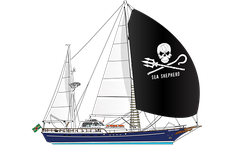
We Need Your Support
Donate funds or supplies, sea shepherd merchandise.
Hakai Magazine
Coastal science and societies, other ways to engage with hakai magazine.
- Sign up for a weekly newsletter
- Audio edition
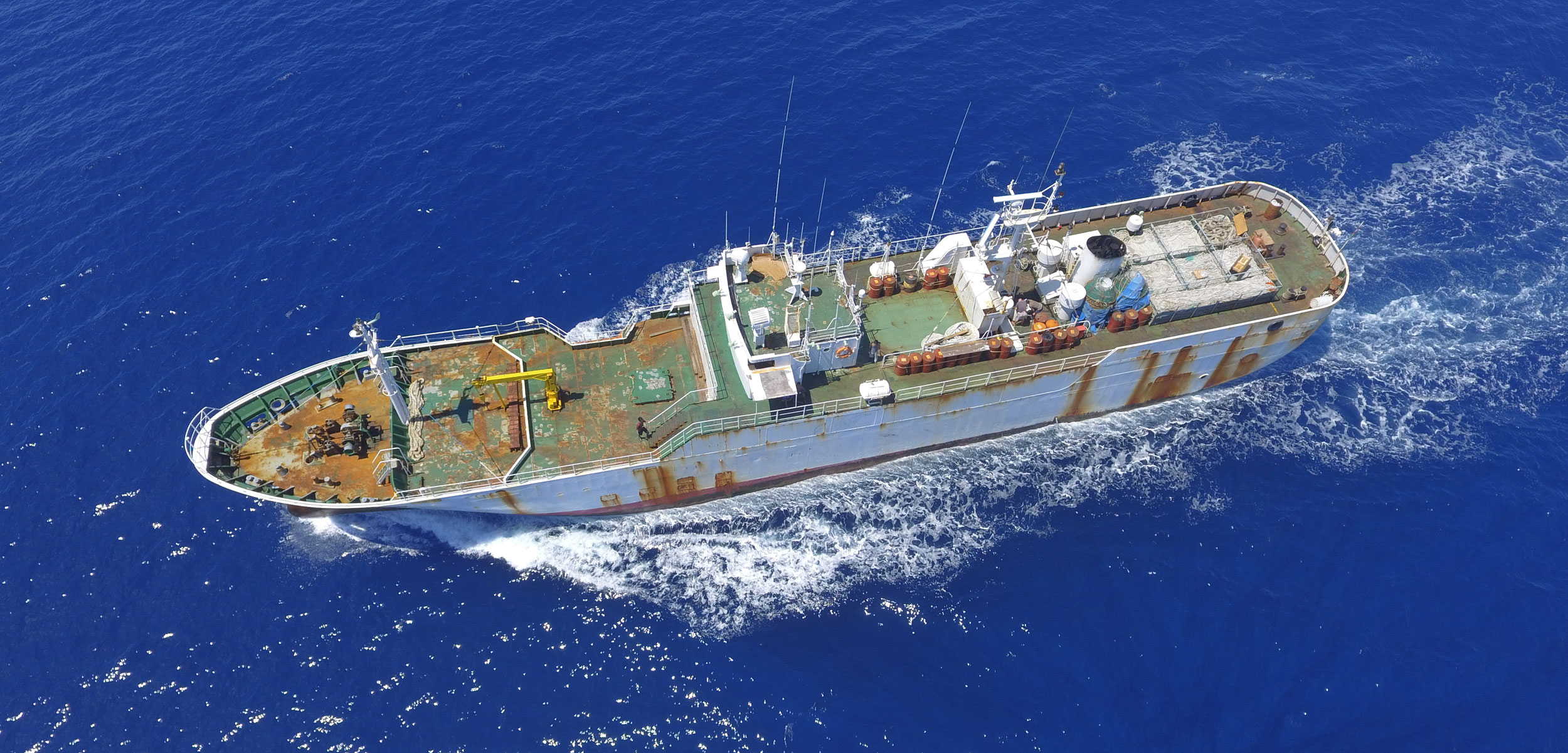
Catch Me If You Can: The Global Pursuit of a Fugitive Ship
The tale of a notorious fishing vessel shows just how difficult combating illegal activity at sea can be., authored by, article body copy.
In the middle of the Indian Ocean in March 2018, a rusty fishing boat cut through the waves as a similarly sized but far-sleeker vessel called the Ocean Warrior followed in hot pursuit.
At 54 meters long and nine meters wide, the Ocean Warrior is equipped with four engines, long-range fuel tanks, a helicopter landing pad, and a water cannon capable of hosing its target with about 20,000 liters each minute. The Sea Shepherd Conservation Society had custom built the US $8-million vessel for running down Japanese whaling ships in the Southern Ocean, but had recently been using it to patrol the waters off Tanzania for illegal fishing boats in partnership with the Tanzanian government and a task force representing eight East African countries called FISH-i Africa. Sea Shepherd provided the boat, crew, and fuel; FISH-i Africa, offered advice borne of experience counteracting illegal fishing operations; and Tanzania provided law enforcement agents who had the authority to apprehend vessels.
The 20-day patrol was supposed to be local, but on the third day, the ship’s team had received a call from a contact in Tanzania: a notorious illegal fishing vessel, the STS-50, had escaped from port in Maputo, Mozambique, where authorities were supposed to be guarding it. Was there anything the Ocean Warrior could do to help? The team agreed to give chase.
The STS-50 was a 452-tonne, 1980s-era former longliner originally from Japan. It was well known in maritime circles under its previous names—the Andrey Dolgov, the Sea Breeze, the Ayda —for poaching Antarctic and Patagonian toothfish (also called Chilean sea bass), two lucrative cod species from the Southern Ocean. Authorities believe the STS-50 operated illegally for 10 years or so and looted up to $50-million worth of the fish, which can grow to 120 kilograms and live for 60 years. Interpol had issued a purple notice for the vessel—an international request for information about the STS-50 ’s criminal activity. But the vessel’s owners and captain had been evading authorities for years with a typical bag of tricks: registering the boat to nations with lax rules; using shell companies to obscure ownership; forging documents; and spoofing the most advanced satellite surveillance.
The STS-50 ’s captain was also a master of escape; the getaway from Maputo was the third time he had given port authorities the slip. This time, the Ocean Warrior crew was determined to keep their eyes on the target. But, after chasing the STS-50 for more than 1,600 kilometers across the Indian Ocean, the Ocean Warrior was low on fuel. The predicament forced the Sea Shepherd captain, Mike Dicks, to make an agonizing decision: turn back. It looked like the STS-50 was about to disappear yet again.
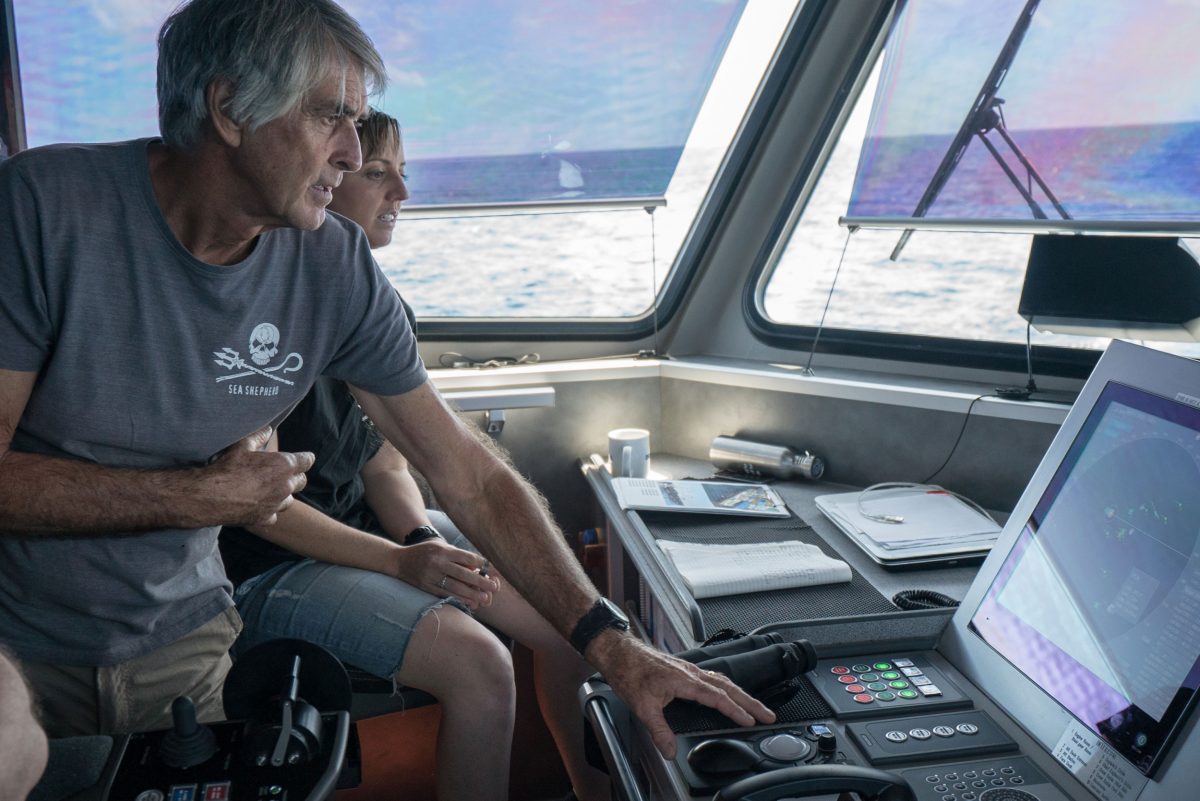
Mike Dicks of the Sea Shepherd Conservation Society and his crew trail the STS-50 after it flees from Mozambique. Photo courtesy of Sea Shepherd
Instead, something else happened. On April 6, 2018, less than two weeks after the Ocean Warrior abandoned chase, Indonesian authorities captured the STS-50 near Banda Aceh. It was a rare victory against an illegal fishing boat, and it highlighted a growing international movement to tackle fishing crimes.
In Latin, the high seas are maria libera—meaning “free seas”—a term that helps explain why criminals see these parts of the ocean as easy places to get rich. Historically, illegal fishing has been nearly impossible to counteract, especially on the high seas, which begin where national jurisdiction ends—370 kilometers from a nation’s shore—and cover two-thirds of the world’s oceans. A loose patchwork of laws and international treaties govern these parts of the oceans, but in most places, they’re rarely enforced, allowing illegal fishing and a plethora of related crimes to go unpunished. Vessels that fish illegally are often involved in human trafficking and drug smuggling while contributing to plummeting fish stocks and degraded marine ecosystems. Experts estimate that up to 20 percent of the world’s total catch (fish and other marine fauna) falls under illegal, unreported, and unregulated (IUU) fishing. That’s more than 23 million tonnes of seafood stolen from the seas annually—or one out of every five wild-caught fish sold on the market—worth $23.5-billion.
Just six years ago, the STS-50 probably would have gotten away, says Per Erik Bergh, the secretary of Stop Illegal Fishing, an Africa-based nonprofit. But around that time, international authorities and nonprofits began working together more closely to take down illegal vessels. As the players gained one another’s trust, a powerful weapon in the fight against illegal fishing emerged. Ending the STS-50 ’s reign of pillage had taken countless hours of work by dozens of collaborators across 40 nations: fishers, port authorities, government officials, and representatives from existing coalitions designed to combat marine crime.
For Peter Hammarstedt, the director of ship operations for Sea Shepherd who helped coordinate the Ocean Warrior ’s pursuit from land, the effort to capture the STS-50 was a testament to the global nature of fisheries crime—and the global solutions required to stop it. “It was exciting,” Hammarstedt says, “to know that all these countries were working together to make sure this one vessel would not get away.”
There were major challenges and a bit of luck, Bergh says, but in the end, “it all worked and you just don’t often see that.” The demise of the STS-50 served as proof that the collaborative enforcement model was making progress.
In February 2018, about a month and a half before the STS-50 ’s capture, Antoine Jeulain was sitting alone in his office in Antananarivo, the capital of Madagascar, when he received disturbing news. At the time, he was the French liaison officer at the Madagascar-based Regional Maritime Information Fusion Center, a new information sharing initiative for combatting illegal fishing in the western Indian Ocean.
A vessel called the STS-50 had arrived at Fort Dauphin (also known as Tolagnaro), a port on the island’s southeast coast. The boat was evidently registered to Togo, a small West African country, and had come to port because of mechanical issues.
An inspector with the Madagascar fisheries control agency had boarded the STS-50 and found suspicious documentation. He took a picture and sent it to the Indian Ocean Tuna Commission (IOTC), an intergovernmental organization that manages tuna in the region. The IOTC confirmed that the document was forged. When Jeulain heard the news through his network, he began making inquiries of his own. From Interpol, he learned that the STS-50 was wanted by seven nations for illegal fishing. Jeulain then checked to see if the vessel’s certification was valid. An official from Togo sent him the response: “We wish to inform you that it’s fraud.”
But by the time Jeulain received the email, the STS-50 had left Fort Dauphin. He relayed pictures and the STS-50 ’s last known positions to his networks in African ports, hoping they would be ready when the rusty ship re-emerged.
At that point, the STS-50 might have remained just another one of the numerous illegal fishing vessels that have eluded capture for years. An estimated 168 IUU fishing vessels operate on oceans around the world.

The STS-50 went by several different names over the years. It started out in Japan in 1985 as the Shinsei Maru No. 2 . Photo courtesy of Sea Shepherd
Illegal fishing has confounded fisheries managers for years, says Christian Bueger, an expert in maritime security and a professor of international relations at the University of Copenhagen in Denmark. Coastal nations have typically viewed the issue mainly as an environmental management problem instead of as organized crime.
But in many parts of the world, illegal fishing has become a clear threat to coastal security. In Somalia, for example, some locals who have taken to piracy claim it’s a way of guarding their waters against foreign poachers. As the impacts of illegal fishing ripple out, countries are taking the problem more seriously.
To address mounting fisheries crimes, Interpol, with support from Norway and a grant from the Pew Charitable Trusts, launched Project Scale in 2013. Nonprofits such as Sea Shepherd and FISH-i Africa, which is associated with Stop Illegal Fishing, and fusion centers such as the one Jeulain was helping build (themselves cooperative entities representing multiple nations) joined the effort. A key part of the project’s work is determining which vessels pose a high risk of carrying out illegal activity based on past behavior and then sharing that information among port authorities, coast guards, and fisheries inspectors around the world. The partners look for boats that have forged paperwork, frequently changed their names and countries of registration, or been involved with illegal fishing in the past. The expertise they honed proved invaluable when the Project Scale players joined the hunt for the STS-50 .
The Southern Ocean comprises a swath of sea encircling Antarctica and makes up roughly 15 percent of the world’s ocean area. Though often thought of as too inhospitable for human activity, the region is hardly an untouched wilderness. Seven countries lay territorial claim to slices of the region and the resources it contains. In the late 1700s, people first hunted Antarctic fur seals, driving them close to extinction by 1825. They moved on to elephant seals and some species of penguins for their oil. Whaling began soon after, and then krill fishing began in the late 1970s.
In response to the growing commercial interest in the region, a group of 26 countries got together and formed the Commission for the Conservation of Antarctic Marine Living Resources (CCAMLR), established by international convention in 1982 with the goal of protecting Antarctic marine life. CCAMLR sets the fishing quotas for the Southern Ocean, but illegal fishing vessels can easily sidestep the directives: boats registered to non-CCAMLR member countries are not subject to the commission’s rules, making prosecution all but impossible.
Before the 1990s, few people had heard of the toothfish. A few decades before at a port in Chile, Lee Lantz, an American seafood merchant on the hunt for new fish species, had come across a fish with buttery, mild flesh high in omega-3 fatty acids that was hard to overcook. But the toothfish, with fearsome teeth and a protruding lower jaw, looked as ugly as its name, so Lantz rebranded it as Chilean sea bass. It became so popular that a single fish could sell for thousands of dollars. By the mid-1990s, CCAMLR reported that illegal toothfish hauls had hit over 68,000 tonnes—more than twice the legal quota. Increased surveillance and arrests by countries like Australia and New Zealand have helped curb the poaching activity, but it remains a serious problem.
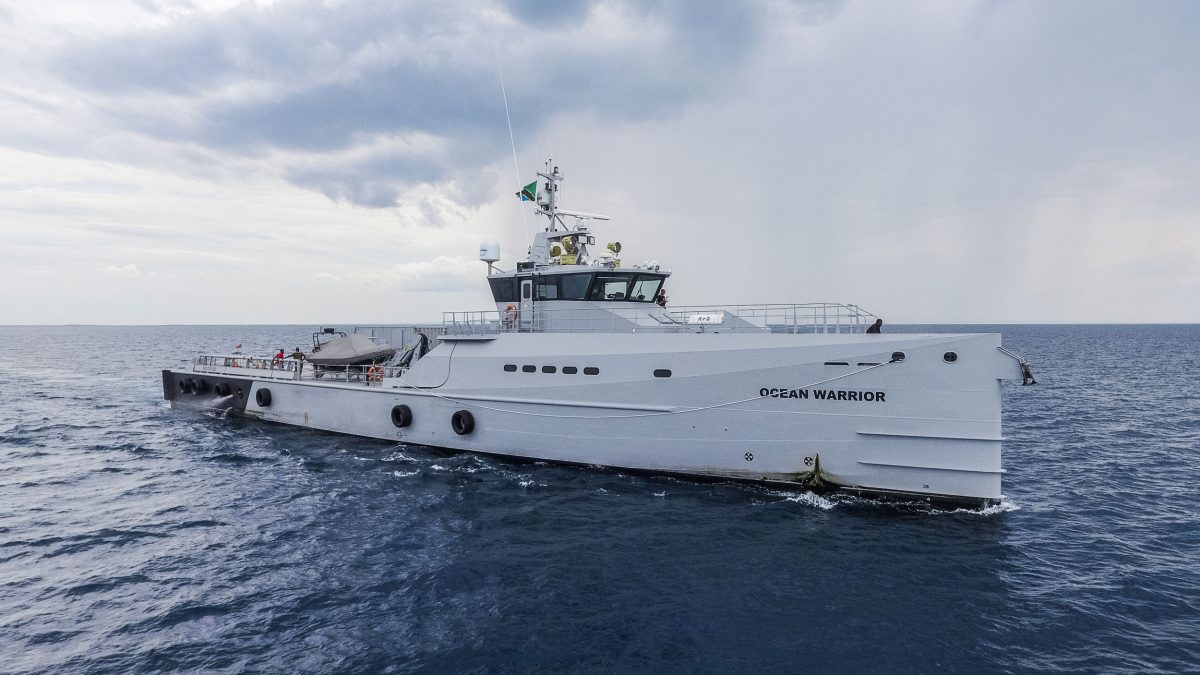
Sea Shepherd’s Ocean Warrior was built as an anti-whaling vessel but has been used to combat illegal fishing. Photo courtesy of Sea Shepherd
Selling the illegally caught fish is relatively easy to get away with if port inspectors do a poor job of investigating the vessel, explains Peter Horn, the project director for the Pew Charitable Trusts’ ending illegal fishing program. All the captain has to do is misreport the catch, claiming for instance that the crew caught one type of fish when in fact it caught another; lie about the quantity of fish caught; or pretend to have fished in a different area. The end result is a market with so many illegally caught fish that “there’s a reasonable chance that you have inadvertently bought some,” Horn says.
For IUU fishing boats, the Southern Ocean is delightfully remote—they haul up fish nearly 1,500 kilometers from the southernmost edge of New Zealand’s territorial waters, where it’s difficult for even the closest countries to sustain regular coast guard vessel or aerial patrols. Before the STS-50 arrived on the scene, a notorious fleet of fishing vessels known as the Bandit 6 had been poaching toothfish in the Southern Ocean from 2003 to 2016. With the launch of Project Scale, Sea Shepherd began helping Interpol target the vessels and their owners, including a Spanish mafia group called Vidal Armadores.
One takedown involved a 110-day chase led by a Sea Shepherd vessel across three oceans. The hunt for the illegal ship, the Thunder, ended in April 2015, when its Chilean captain intentionally sank the vessel off the west coast of Africa.
Afterward, Project Scale investigators discovered the identity of the Thunder ’s owner from his insurance claim, which included the loss of 32 tonnes of illegally caught toothfish. “This is how brazen they were,” says Hammarstedt.
In 2015, a court in São Tomé and Príncipe, an island nation off the west coast of Africa, convicted the Thunder ’s captain and two of its crew members on several charges tied to illegal fishing and collectively fined them over $17-million.
By early 2016, the five other Bandit 6 vessels had met similar fates, and for a while, the Southern Ocean was free from major illegal fishing operations.
With the Spanish vessels gone, the STS-50 moved in to fill the void.
The STS-50 had been fishing illegally around the world at that point for eight years under a variety of names, likely selling its catch to middlemen who knew it was illegal, says Bergh of Stop Illegal Fishing.
The crew would have changed often and it’s possible some would not have known their activities were criminal, but the senior officers like the Russian captain and the first mate would have been fully aware, says Bergh.
It wasn’t until the fall of 2016 that authorities flagged the vessel for possible violations. After its crew unloaded what looked like toothfish in the port of Weihai, China, raising suspicions that it might have been illegally caught, officials conducted DNA testing that confirmed it was, in fact, toothfish. To legally catch toothfish, vessels must be registered in a country that is a member of CCAMLR—otherwise the catch falls into the category of “unregulated.” The STS-50 was registered to Cambodia, which is not a member. In any case, as Cambodian officials later confirmed, the boat’s registration was forged. But before anyone could stop it, the vessel fled across the Indian Ocean.
In January 2017, New Zealand and Australia requested Interpol issue the purple notice, and officials in partner countries went on high alert. By this time, the vessel had been renamed the Sea Breeze and then again the Ayda . When it arrived at ports, the captain, Aleksandr Matveev, presented forged documents to obscure its identity and claimed the boat belonged to at least eight different flag states including Togo, Nigeria, and Bolivia—all countries with lax maritime laws. Registering a ship under one of these so-called flags of convenience is a common tactic used by owners of IUU fishing vessels since a ship generally falls under the jurisdiction of the flag state.
The vessel’s owners disguised their identities through a convoluted network of shell companies—businesses that exist only on paper. A 2019 report by the Center to Combat Corruption and Cronyism notes that “large-scale reform is needed in the global fishing sector to improve how vessel owners report ownership information and prevent the exploitation of opaque jurisdictions and flag states.”
Your browser does not support the video element.
Before abandoning their pursuit of the STS-50, the Ocean Warrior crew flies a drone over the illegal vessel. Video courtesy of Sea Shepherd
A year after the STS-50 left Weihai, the vessel returned to China and was arrested but fled the same day. The ship evaded authorities until February 2018, when the fisheries inspector in Madagascar found the suspicious document on board .
“Madagascar was really brilliant,” says Bergh, referring to the inspector’s decision to alert the IOTC. “They had their suspicions and sent them out.” Had they not done that, he adds, it might have taken the authorities far longer to track down the vessel.
As soon as the STS-50 fled Fort Dauphin, various players, including FISH-i Africa and Stop Illegal Fishing, began tracking the vessel via its automatic identification system (AIS), which emits a location signal that can be picked up by radio equipment and satellites to help vessels avoid collisions at sea. Those groups shared that information with other players, including Jeulain at the Regional Maritime Information Fusion Center and officials in Indonesia, Australia, and New Zealand. By pooling their various intelligence sources, Jeulain says, they could increase their strategic advantage on the STS-50.
“You send the ball over to another player who can bring added value to the play,” he adds.
On February 27, 2018, two weeks after the STS-50 had slipped away from Madagascar, Jeulain received another email, this time from one of his contacts in Maputo. The informant said the vessel had moored near Maputo a few hours earlier. The STS-50 had not requested permission to enter Mozambican waters, and authorities boarded the vessel to inspect it. They found fishing gear, though the boat was not authorized to fish. Mozambican officials arrested the vessel, brought it to port in Maputo, and confiscated the crew’s passports—20 Indonesian, eight Russian, and two Ukrainian.
But two weeks later, on March 18, the STS-50 fled again. How such a large vessel wanted for illegal fishing could have escaped from a major port remains a mystery. (A person familiar with the case refuses to speculate on what may have happened but says that Mozambique is a country where “cash is helping you a lot.”)
When news of the ship’s getaway reached Gary Orr, who monitors commercial fishing for the New Zealand government, the elation he had felt when the vessel was detained was quickly replaced by crushing disappointment. “The chase and the apprehension of the bad guys is what it’s all about if you’re an investigator; it’s what you live for,” Orr says.
With investigators on high alert, the STS-50 tried to evade tracking by periodically switching off its AIS and using a generic Maritime Mobile Service Identity ( MMSI ) number, a nine-digit code that is supposed to be unique to each vessel. With the generic identification number, the STS-50 was able to hide under other ships’ transmission signals, says Bergh, “a bit like everybody trying to talk on the same frequency on a radio.” Specialists at Trygg Mat Tracking (TMT), a Norwegian nonprofit that provides vessel tracking analysis to FISH-i Africa, were able to decipher the STS-50 ’s intermittent satellite signals and detect where the vessel really was.
It was like playing a game of cat and mouse in an area larger than the Australian continent. On March 20, Jeulain’s phone pinged. It was a WhatsApp message from one of his regular informants, the captain of a fishing boat off the west coast of Madagascar. He had spotted the STS-50 .
The STS-50 was heading northeast, toward the port of Toliara on Madagascar’s west coast, just as TMT experts had thought. Bergh, who was kept abreast of the tracking efforts, concluded that, at its current speed, the vessel might be there in 14 to 16 hours.
He fired off an email to Jeulain, notifying him of its likely destination.
“OK Per,” Jeulain wrote back. “I have a network of informers at Tuliare [another name for Toliara] and Morombe. I will send the picture of the F/V [the STS- 50] so that my network can spot it if it ever shows up.”
At 63, the Ocean Warrior ’s captain Mike Dicks had served as skipper on two previous Sea Shepherd campaigns. A former airline pilot in Hong Kong, Dicks was a keen sailor and had flirted with becoming a marine biologist. The previous summer, Dicks had helped arrest 15 Chinese vessels in East Timor for illegal fishing and human rights abuses. When officials from East Timor raided the boats, they found freezers jammed with sharks—many of them endangered.
When Dicks received notice that the STS-50 had fled detention in Mozambique, he had to figure out where it would try to flee. Though TMT was tracking the ship, no one was certain where it was headed. “It was more of a guess-and-check type scenario,” as Orr puts it. A cyclone off the east coast of Madagascar left the STS-50 with just one likely escape route: northward up the Mozambique Channel and then east across the Indian Ocean into international waters.
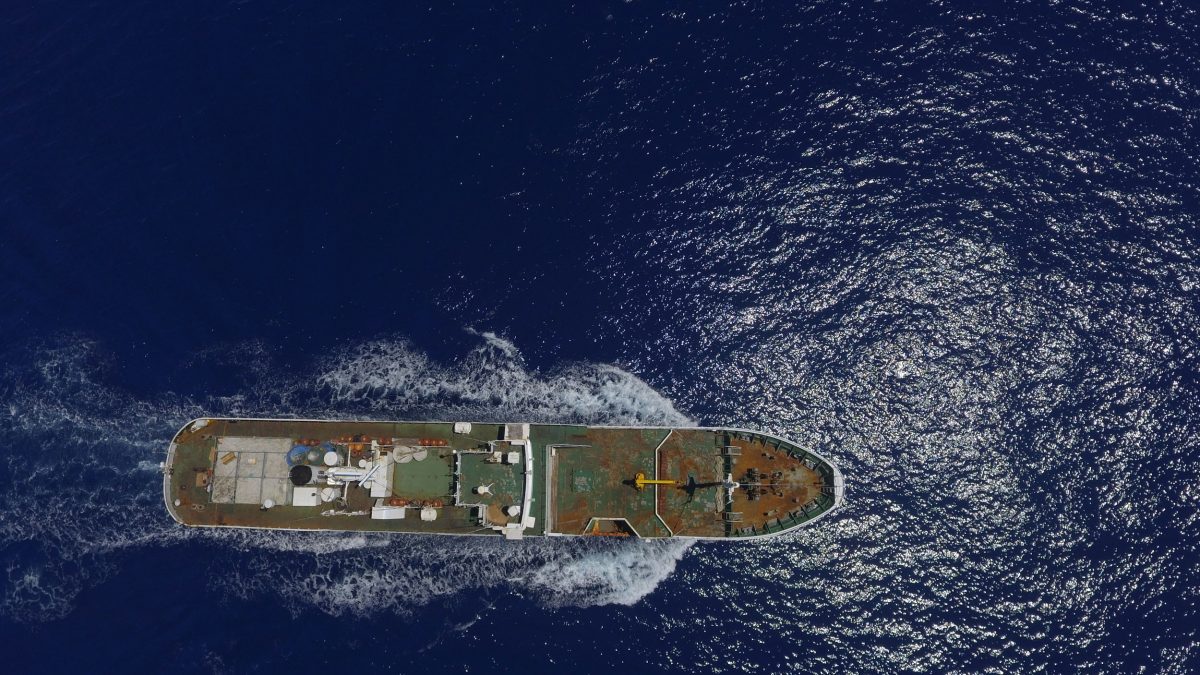
After leaving Madagascar, the STS-50 heads for international waters. Photo courtesy of Sea Shepherd
A few days later, Dicks received position reports that the STS-50 had crossed the Mozambique Channel and was heading north along the west coast of Madagascar, as predicted. Dicks steered the Ocean Warrior southeast from Tanzania, hoping to intercept it.
To conserve fuel, he kept the speed slow, gradually closing in on the STS-50 without raising suspicion in the other vessel’s crew that they were being pursued.
Ahead, the STS-50 passed Comoros, off the north coast of Madagascar, and was headed east toward the international waters of the Indian Ocean—exactly as Dicks had guessed.
Under the United Nations Convention on the Law of the Sea, the STS-50 was a stateless vessel due to its forged paperwork, which meant that any country could seize it in international waters. Tanzania, which had sent officers out on the Ocean Warrior , had volunteered.
“That was an amazing testament to Tanzania’s commitment for fighting environmental crime,” says Sea Shepherd’s Hammarstedt. Most countries are reluctant to go after rogue vessels. Now, Tanzania, with Sea Shepherd’s help, would be responsible for bringing the STS-50 back to port and footing the bill for prosecuting the vessel.
But international waters were still a long way away. To get to where Tanzanian authorities could board the STS-50 , the Ocean Warrior would have to travel far into the Indian Ocean, past the territorial waters of Madagascar, Mauritius, and Seychelles—at least 1,800 kilometers from the Tanzanian coast, according to Dicks’s calculations—which put the ship at the far edge of its fuel supply. Without enough diesel, the Ocean Warrior would have to make the return trip on its electric engine—at a much slower pace—pushing the homeward journey to 10 days. There was a chance, though, that with permission from the relevant nation, the Ocean Warrior team could arrest the STS-50 in territorial waters.

A view of the Ocean Warrior ’s bridge. Photo courtesy of Sea Shepherd
As the chase progressed, Dicks saw that it was becoming a logistical nightmare. How would they get the STS-50 all the way back to Dar es Salaam, Tanzania’s closest major port? Only three of the Tanzanian officials aboard the Ocean Warrior were armed and they would need to guard the 25 people aboard the STS-50 for the entire journey. These are the same people who had just escaped port twice in the past four weeks. What if they were aggressive? Or had guns? Dicks was not certain he could guarantee the safety of the Tanzanians or the other 18 people aboard the Ocean Warrior .
Given Dicks’s growing concerns, Tanzania requested permission from Seychelles to seize the vessel while it was in Seychellois territorial waters, but their inquiries went unanswered.
By this point, the Ocean Warrior had nearly caught up to the STS-50. Dicks kept them 24 to 32 kilometers away—close enough to see the STS-50 on the radar. As they approached international waters, it was looking increasingly unlikely that they could apprehend the STS-50 . The decision to turn back just beyond the island of Mauritius was “gut wrenching,” says Dicks. “We’d been chasing them for a week and we just had to let it go.”
Before turning around, Dicks steered the Ocean Warrior closer to the STS-50 while the crew deployed a drone to take pictures in hopes that it would help authorities eventually identify the vessel and capture it.
The STS-50 charged on toward Indonesia, on the other side of the Indian Ocean. But it had picked the wrong country to escape to.
With the STS-50 cutting across the ocean, Hammarstedt messaged Mas Achmad Santosa, the head of Indonesia’s storied task force for combating illegal fishing. Since 2014, the country, which contains 17,000 islands, has blown up more than 400 illegal fishing boats.
In February 2016, the Indonesian navy, with Sea Shepherd assisting, had caught the last of the Bandit 6 ships—a vessel called the Viking . A few weeks later, Indonesian officials loaded the Viking with explosives and blew it up.

The illegal fishing boat known as the Viking , captured before the STS-50 , in Indonesian waters. Photo by ZUMA Press, Inc./Alamy Stock Photo
“This is to serve as a deterrent to others,” Susi Pudjiastuti, Indonesia’s fisheries minister at the time, told a group of reporters as she stood on the beach while the Viking smoldered behind her. “You may go freely in the rest of the world, but once entering Indonesia, this is the consequence.”
To Jeulain, Bergh, Hammarstedt, and the huge network of people invested in the STS-50 ’s capture, the end looked to be in sight. Indonesian authorities were ready to intercept the vessel as soon as it entered its waters.
Still, no one knew exactly where the STS-50 was. Without the Ocean Warrior following directly behind the vessel, they had to rely on its AIS signal to determine its location, but the STS-50 was transmitting only occasionally, likely to keep the owner abreast of its location. Whenever the STS-50 signaled, the tracking experts in the network keeping watch would estimate its course until it transmitted another signal, 48 hours or so later.
“When it gets closer to shore, that’s when it gets more tense,” Bergh says. As it approached the boundary for Indonesian waters, Bergh and his collaborators anxiously awaited that final, crucial signal that would allow the Indonesian navy to intercept the vessel.
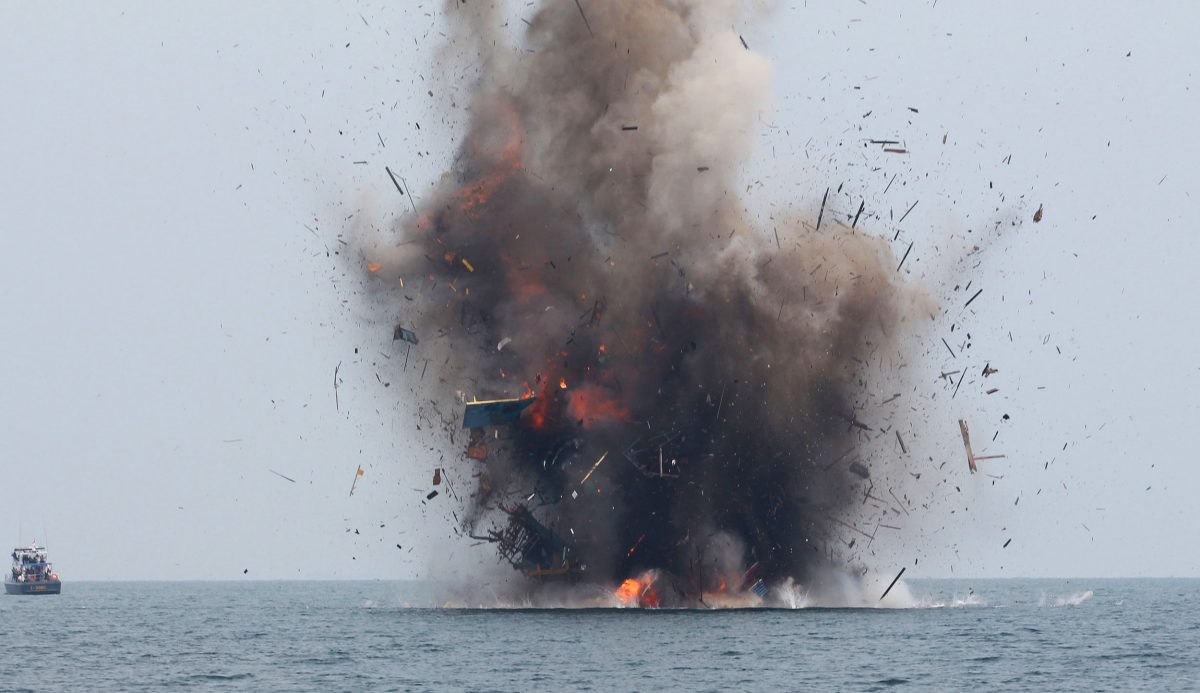
The Indonesian government takes an aggressive approach to defeating illegal fishing vessels, claiming to have sunk hundreds of such ships in its waters. Photo by Januar/AFP via Getty Images
“We knew it was approaching Indonesia, but we hadn’t seen it in a long time,” Bergh says, referring to an 18-hour period when the STS-50 ’s signal went dark. “Everyone was asking, ‘Where is it? Where is it?’”
Finally, they saw it—a little blip coming toward Banda Aceh.
As soon as the STS-50 entered Indonesian waters, two Indonesian navy vessels intercepted it and asked to board, which the captain and crew allowed. Usually people on board fishing vessels don’t resist, says an official who asked not to be named. Especially with Indonesia’s reputation: “How do I put it?” he says. “They’re very … efficient … with law enforcement.”
On the high seas, the bad guys have almost always gotten away—a frustrating reality of the seemingly Sisyphean task of policing lawbreakers in such a vast arena.
By the time the Ocean Warrior arrived back in Dar es Salaam and refueled, only four days of its originally scheduled patrol were left. Dicks steered the vessel up the Tanzanian coast toward the Kenyan border and arrested a rickety wooden boat that was smuggling migrants. “Small fry, really,” says Dicks.
The STS-50 managed to fish illegally for years because its captain had a knack for making the ship scarce. This animation, intended to illustrate the timeline of the STS-50 ’s capture, provides only an approximation of the ship’s route across the ocean. Animation by Katrina Pyne
The STS-50 was not small fry, but punishing those responsible for the vessel’s crimes proved more difficult than catching it. The captain was sentenced to a mere four months in Indonesian prison and fined $14,000 by an Indonesian court for illegal fishing. The other officers were deported back to Russia and Ukraine, their home countries. Still, punishing the real perpetrators was more difficult.
“To this day, we still can’t target the owners,” Pudjiastuti said at a press conference at her office in Jakarta, Indonesia, in early 2019. “The beneficial owners aren’t clear, so it’s difficult for us to track them down.”
After the arrest, Interpol’s digital forensics teams pored over the intelligence contained within the fishing vessel—its on-board computer systems, navigational instruments, and the captain’s mobile phone—helping authorities piece together the wider criminal web that the vessel operated in. Rather than blow up the captured illegal vessel, Indonesia has converted the STS-50 into one of its maritime policing boats.
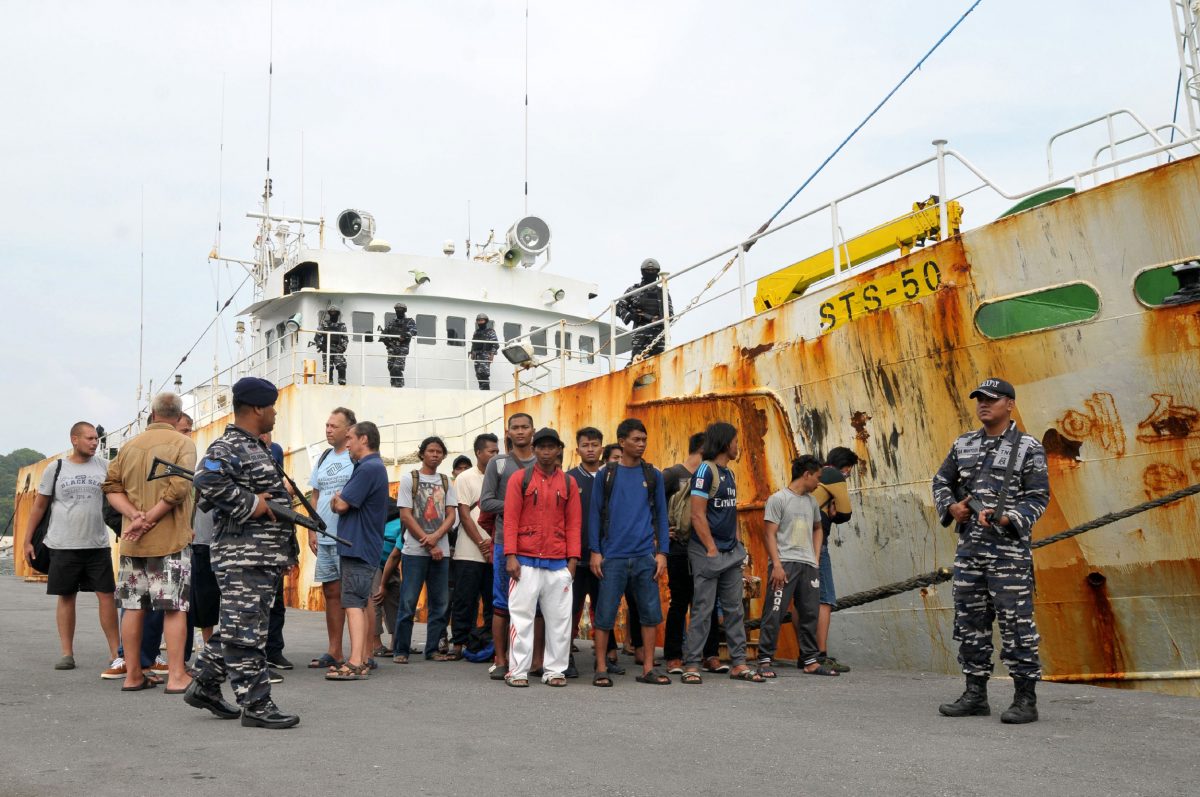
Indonesian guards stand with crew members from the STS-50 after the ship’s capture in April 2018. Photo by AFP via Getty Images
In the fisheries management world, many people see capturing illegal fishing vessels as government work. That attitude has always frustrated Bergh. If illegal vessels can easily slip between borders, capturing them requires not only governments—which tend to have limited and confidential intelligence—but also, evidently, many other players working together. “These cases are puzzles,” he says. Some organizations dedicate years to investigating certain criminals or cases—when that hard-won information is shared with other agencies, everyone benefits, he adds.
For Bergh, the apprehension of the STS-50 demonstrates what is possible when governments, law enforcement, and civil society work across the political boundaries that once constrained them. And though Bergh acknowledges that stopping one vessel doesn’t turn the tide against illegal fishing, it does show that the net is tightening.
Correction: A previous version of this story incorrectly stated that 312 IUU fishing vessels are in operation. The number has been updated.

On Water: Captain Mar Casariego Of Ocean Warrior
Aug 26, 2020
The original article was published on the Sep-Oct’20 issue of Longitude, ONE°15 Marina’s Club magazine. Read it here.
Protecting the world’s oceans is all in a day’s work for this young yacht captain and green activist.

Mar Casariego profers a wide smile as she invites us into her abode, the 54-m yacht Ocean Warrior, which she captains for the Netherlands based marine conservation group Sea Shepherd. The research and patrol vessel is currently docked at ONE°15 Marina Sentosa Cove for maintenance works. Being able to house yachts of up to 200ft makes makes the marina a favourite berthing spot for owners and captains. Besides the Ocean Warrior, the marina was also home briefly to superyachts such as Batavia and Latitude.
We move to the bridge for the interview with Casariego sitting ensconced in the captain’s chair.
It is hard not to immediately warm up to the Spaniard, yet Casariego’s friendly demeanour and diminutive build belie a steely resolve to play her part in safeguarding the world’s oceans and its marine life. The 27-year-old is strongly passionate about sustainability, and leads a crew comprising mainly volunteers to fight illegal fishing around the globe. It is a calling that stems from a deep-rooted love of the sea spanning years; her first name itself, “Mar”, is Spanish for “ocean”.
Casariego was born in Palafrugell, a municipality located north of Barcelona. Her father, an engineer by profession, was the lighthouse keeper for her village. Fuelled by a diet of books detailing adventurous trips to faraway lands, the younger of two siblings (she has an older brother) started sailing as a child, joining her dad on expeditions and later landing a job as a sailing instructor in her teenage years.
The international law and human rights studies university graduate soon decided to chart her course to larger vessels. Casariego started working on superyachts as a crew member, and took a year off after her studies to traverse the globe and “learn a bit more about the world”. “I love to be at sea and have always been involved with volunteering and the environment, so I thought it would be a good idea to travel and volunteer at the same time,” she declares.
It wasn’t long before she heard about non-government organisation (NGO) Sea Shepherd and its work thwarting Japanese whaling ships in the Southern Ocean; famously the subject of Discovery Channel’s reality TV series, Whale Wars. “I decided to apply (to join Sea Shepherd), and they accepted me,” she says. “It was kind of the perfect time.”
Casariego started out as a deck hand even though she already had a captain’s licence and prior maritime experience. “You usually come on board as a deck hand so you have time to learn about the ships and the way Sea Shepherd works,” she says. The diligent Casariego showed her mettle and was promoted to the position of first mate after just one month.

Today, as master and commander of the Ocean Warrior, she oversees the vessel’s campaigns, its crew (who incidentally are all vegan), and navigation. “We focus on any type of threat to the world’s oceans, from marine pollution to illegal fishing to protecting marine reserves or helping governments to start new marine reserves,” she says.
STATE OF PLAY
Being out on the open waters, Casariego has witnessed her fair share of worldly sights and sounds. She revels in the natural beauty and fauna of places such as South America and the islands of the Archipiélago de Revillagigedo. “They have the most amazing marine life, huge Pacific manta rays, and one of the biggest populations of hammerheads in the world,” she enthuses.
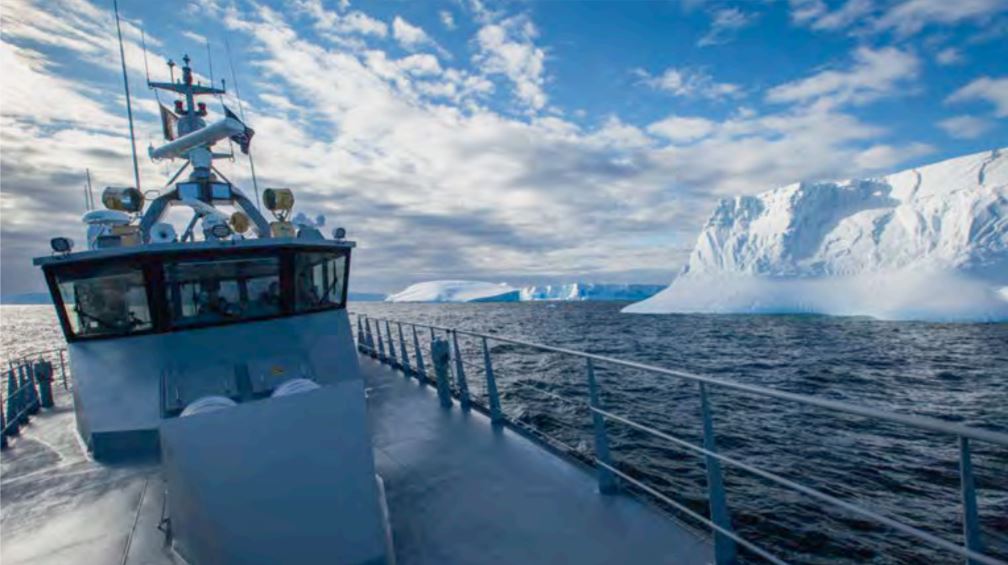
In Singapore for the first time, she is amazed by the fact that she can “get lost” in one of the citystate’s many lush green spaces and still be in “one of the most high-tech cities in the world”. Being vegan, her dietary choices here are more diverse, too. “It’s really nice to be in Asian countries, because tofu is part of the (normal) diet.” And incidently, the tofu in Singapore, she says, is unlike any other she has tasted before.
However, not everything she encounters on her travels is as pleasant. She laments over the destructive effect illegal fishing has on marine stocks, the environment and even humanity. “Trawling, for example, is one of the most destructive ways of fishing. The net just catches everything that is in its path, and it destroys the seabed. The algae cannot recover and that kills everything else because without algae, the whole food chain is affected.”
Compounding matters is the human element, specifically the exploitation of improverished communities. “Due to their situations or low incomes, many people are forced to become fishermen, and they get onto boats that don’t give them a place to sleep, or proper food, or a healthy number of hours of work,” she says. “They are not treated well, and not allowed to contact their families or go back home. This is a huge problem that we are supporting by buying fish.”
A BETTER TOMORROW
Yet Casariego fights on, doing what she can to fulfil her vision of a brave new world with recovering oceans and thriving marine life, her youth and gender notwithstanding. “I get lots of surprised faces,” she laughs. “When we arrive at a new port and a person asks for the captain and I go down, they say, ‘But I want to speak with the real captain’.” However, her team knows who’s boss. “I am really lucky with my crew. They are very respectful and understand that anyone can be captain as long as they have the right certification and the right attitude.
“Knowing that every day I am at work, be it maintenance on the ship or being out on campaign, goes towards something I believe is good for the world is an amazing feeling,” adds the self-described “perfectionist”, who practises yoga on board to keep herself fit. “I’d like to think that all the struggles I go through because I am a woman are helping all the girls behind me who want to become captain someday.”
NO EFFORT TOO SMALL: CAPTAIN MAR CASARIEGO ON LIVING SUSTAINABLY
1. AVOID SINGLE-USE PLASTICS. “A future without single-use plastics would be a big thing. The amount of plastic I’ve found everywhere, even in the most remote places, is just unbelievable.”
2. TRAVEL JUDICIOUSLY. “I try to travel in a conscious way. I will travel by bike instead of taking a car, if I can car pool, I will. If I can go by train instead of taking a plane, I will do that. I always try to pick the option that has the least impact on the Earth.”
3. CONSUME LESS. “Society pushes us all the time to buy more things and own new things, but we really don’t need them. It actually makes us more stressed. This is something I really learnt about on ships, because when you are out at sea you don’t have supermarkets, you don’t have shops, and you can’t even buy online because you don’t have an address to send your purchases to. We can be as happy and enjoy ourselves as much as we do now without buying things.”
Read more on how we can do our part and start from young with these simple eco-friendly tips.
A WATCHFUL EYE: NGO SEA SHEPHERD, IN A NUTSHELL
Sea Shepherd was founded in June 1977 in Vancouver by former Greenpeace activist Paul Watson. Its work chasing Japanese whaling fleets propelled it to global prominence, before it switched focus in 2017 to thwart illegal, unreported and unregulated fishing practices such as shark finning, illegal by-catch and fishing without a licence. The NGO shares its expertise and resources, namely its 14 vessels and 160 crew, with various governments globally in a bid to combat such illicit maritime activities.
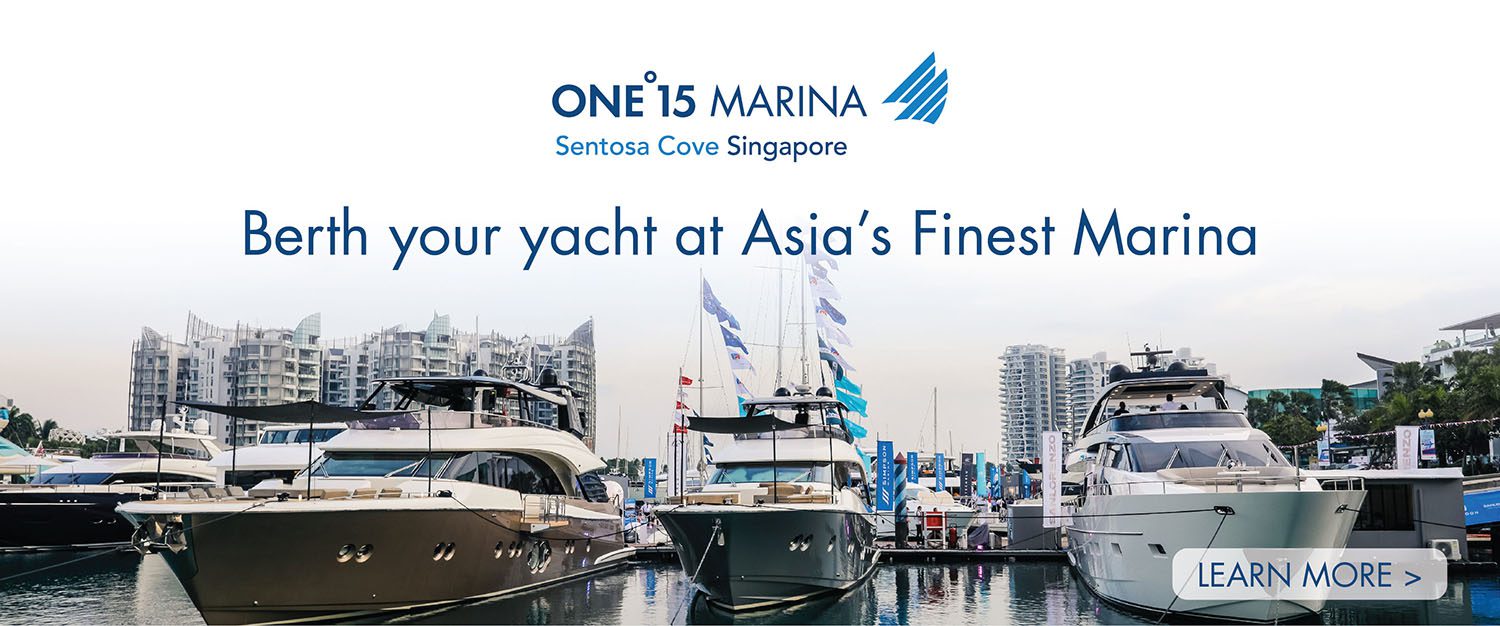
RELATED NEWS
Simple eco-friendly tips for kids, pledge to protect: one°15 marina coral garden updates, on water: interview with captain edward shiels of latitude.
- Get Involved
- Our Campaigns
Popular Searches
- IUU fishing
Neptune’s Navy
The sea shepherd fleet.
Since 1977, a number of vessels have served in the Sea Shepherd fleet to protect marine wildlife in direct-action campaigns around the world. Click the links below to learn more about our current vessels used to defend, conserve and protect the ocean.
- Ocean Warrior
- Age of Union (formerly M/Y Sam Simon)
- Sea Eagle
- Emanuel Bronner
- Bob Barker (retired)
Our vessels

Ocean Warrior
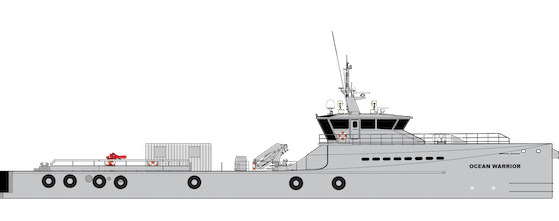
In 2015, at the annual Goed Geld Gala (Good Money Gala) hosted by the Dutch Postcode Lottery in Amsterdam, Sea Shepherd Global was awarded €8.3 million for a “Dream Project” vessel built to "Stop Illegal Fishing in the Southern Ocean".
It was constructed by Dutch shipbuilder Damen in the port of Antalya, Turkey, and christened Ocean Warrior in September 2016. Its maiden voyage was Operation Nemesis , Sea Shepherd’s 11th Antarctic Whale Defense Campaign, in 2016/2017.
The M/Y Ocean Warrior is Sea Shepherd’s first custom-built ship, and the fastest in the fleet, reaching speeds over 25 knots.
Technical Information
- Type Patrol vessel
- Launched 2016
- Weight 454GT
- Speed 25+ knots
- Max Crew 16
Age of Union
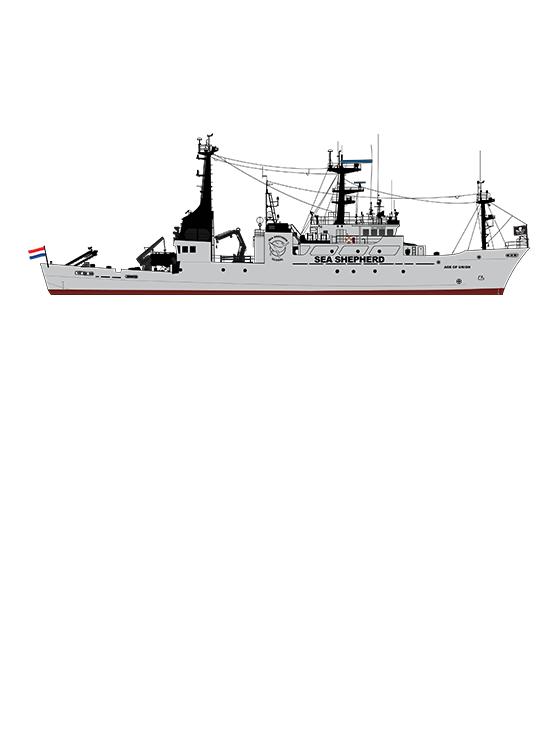
The Age of Union , previously known as the Sam Simon, was named after our partners at the Age of Union Alliance, following a very significant pledge of support at the very beginning of 2022.
The vessel first joined the sea shepherd fleet under the name sam simon, after the hollywood producer and animal rights advocate who served on sea shepherd’s board of advisors until his passing in 2015. his generous donation made it possible to purchase the former japanese vessel in 2012, when it joined its first antarctic whale defense campaign that december, operation zero tolerance., the sam simon , originally named the seifu maru, was a meteorological observation ship for the japanese whaling fleet..
- Type Research/survey vessel
- Launched 1993
- Weight 720GT
- Speed 11 knots
- Max Crew 35
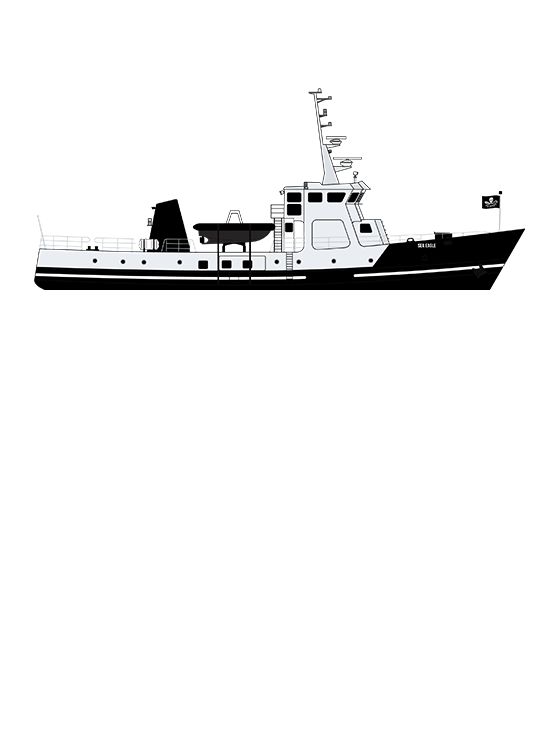
In 2021, the Sea Eagle was purchased through funding from Allianz SE, Allianz Technology, and Allianz Italy as part of Sea Shepherd’s new two-year partnership with Allianz to address the issue of plastic marine debris polluting the ocean.
The vessel is a former French pilot boat that carries two small boats. Having been built for the Atlantic Ocean, the ship is capable of navigating the roughest seas.
- Type Pilot vessel
- Launched 1986
- Weight 318GT
- Length 34.95m
- Speed 12 knots
- Max Crew 19
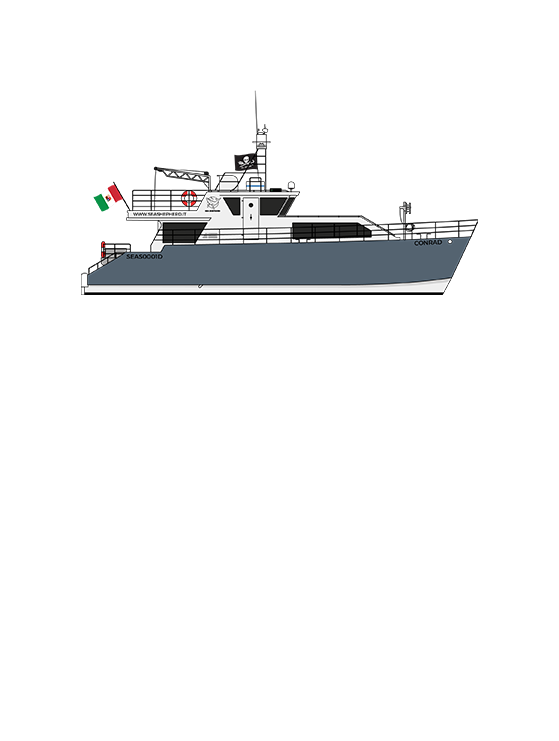
The Conrad is a 17-meter catamaran donated by Jane Patterson and Sebastiano Cossia Castiglioni (the latter a member of Sea Shepherd Global and US Board of Advisors and Sea Shepherd Italia’s Council of the Wise) in 2020.
Equipped with a RHIB fast boat, the Conrad has been used on OperatIon Siso : our campaign to protect Italy’s Mediterranean waters from illegal fishing.
- Type Catamaran
- Launched 2020 (by Sea Shepherd)
- Weight 30 GT
- Speed 17 knots
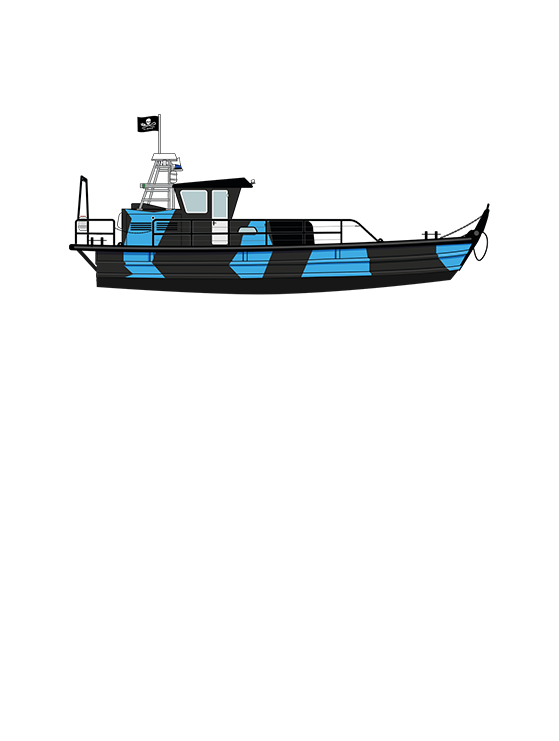
Sea Shepherd's first landing craft was named by Captain Paul Watson after the Selkies (seal folk) from Celtic and Norse mythology.
Commissioned by the Ministry of Defence in 1984 and completed in 1985 at the Souter shipyard at Cowes (Isle of Wight, UK), the Landing Craft Vehicle Personnel (LCVP) Mk.4 was designed to operate from the Royal Navy's amphibious warships HMS Fearless and HMS Intrepid. Decommissioned in 2012 then fully re-built in 2016 with further modifications in recent years, LCVP Selkie opens up more possibilities for Sea Shepherd UK's campaigns than traditional boats and RIBs with the ability to land on almost any beach, embark a load of 5500 kg and then retract back to the sea.
LCVP Selkie will now be tasked on coastal patrol work, diver deployment, ghostnet recovery, and marine debris retrievals from otherwise inaccessible areas of the UK's coastline and islands.
- Type Landing Craft Vehicle Personnel
- Launched 1985
- Weight 11GT
- Speed 20+ knots
Emanuel Bronner
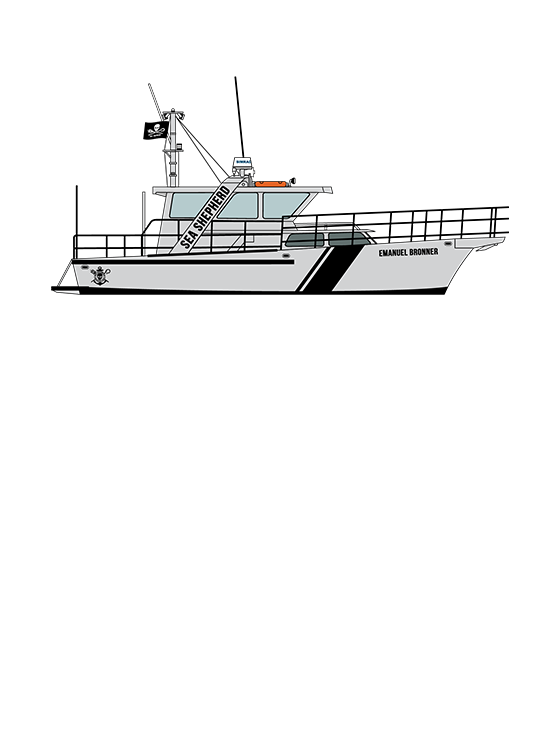
The Emanuel Bronner is a small ship owned and operated by Sea Shepherd as a Baltic Sea conservation patrol vessel. Unveiled in 2017, the ship was donated by philanthropist Michael Bronner and named after his grandfather, Emanuel Bronner. The vessel is responsible for helping to protect the endangered harbor porpoise in the Baltic Sea.
- Launched 1970
- Weight 9 GT
- Length 11.65 m
- Speed 20 kn
Bob Barker (Retired)
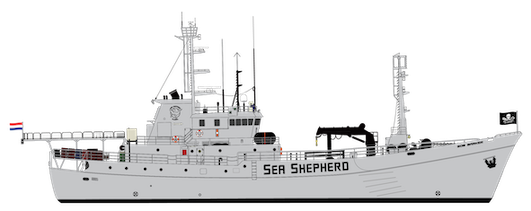
Thanks to a $5 million contribution from the legendary American game show host Bob Barker, in 2009 Sea Shepherd secretly purchased and refitted a former Norwegian whaler in Africa. The ice-strengthened chaser boat quietly departed from Mauritius on December 18th for its first mission against the Japanese whaling fleet , Operation Waltzing Matilda.
The Bob Barker originally operated as a whaling ship until 1962, and later confronted Sea Shepherd during its life as a Norwegian Coast Guard vessel.
- Type Long-range ice class research vessel
- Launched 1950
- Weight 488GT
- Length 52.2m
- Speed 15+ knots
- Max Crew 36

Steve Irwin (Retired)
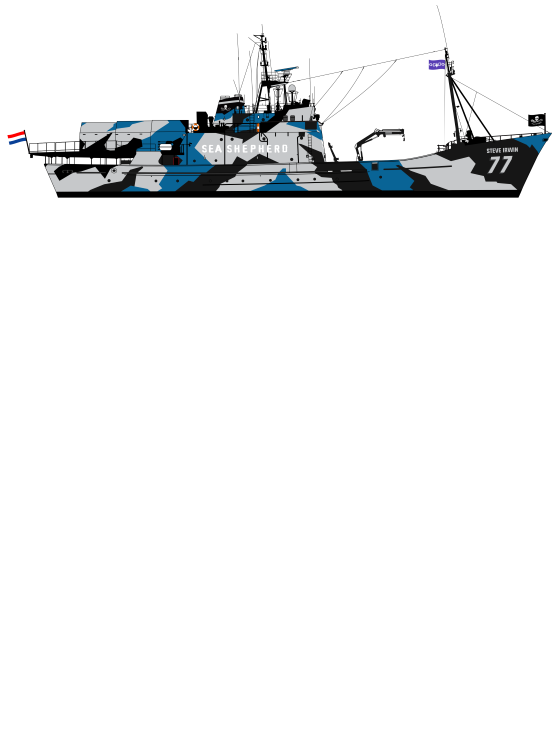
Purchased in 2007, Sea Shepherd's former flagship vessel was previously operated by the Scottish Fisheries Protection Agency. It was initially named Robert Hunter after the Canadian co-founder of Greenpeace who died in 2005.
Its first expedition was the 2006/2007 Antarctic Whale Defense Campaign Operation Leviathan .
The ship was renamed Steve Irwin in December 2007 in honor of the late Australian conservationist and Sea Shepherd supporter.
- Type Island class patrol vessel
- Launched 1975
- Weight 1017GT
- Length 59.5m
- Speed 15 knots
- Max Crew 42
Thank you. Please consider sharing with your family and friends to help save more marine lives!
Meet the Ocean Warrior's New Smallboat!
Hey everybody! Jesus, the bosun on our flagship, the actual M/Y Ocean Warrior wanted to show off our new boat small boat and launching system! Because of the work we are doing these days, we are outfitting our ships with beefier boats. These are actually designed for military use, not for leisure or tourism or any civilian purpose, as you will likely be able to tell. Instead of the inflatable pontoons on the side, they feature rigid foam, and in place of the outboards, we have inboard engines connected to two incredible jet drives. But this boat doesn’t just look good, it operates amazingly, flying through any sea state we have had it in so far!
To launch the new boat, the ship’s crane has been replaced with a davit – a state-of-the-art piece of kit, based on the very first launching mechanisms for small boats on ships. They are tried and tested to be able to work exactly as we need them to, and together with it and the small boat, the Ocean Warrior is now even more capable than before, to bring the fight to the poachers!
Since our comments are now open here on our Ocean Warriors site, let us know if you have any questions about the new boat or the Ocean Warrior !

Captain Adam Meyerson - Sea Shepherd's MY Ocean Warrior
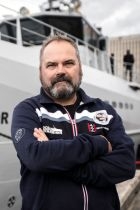
Meeting MY Ocean Warrior Captain Adam Meyerson - even if it is over a slightly dodgy Skype connection half a world away in Perth, Australia - is something of a privilege.
It’s not every day you get to interview someone whose day job is to hunt down whalers and illegal fishing craft while protecting our precious oceans and marine life. Let’s put it this way…my job suddenly feels quite pedestrian compared to Adam’s daily grind.
As Captain of Sea Shepherd’s newest yacht in the fleet – which was funded by the Postcode Lottery and delivered last September - Adam has just arrived back from Operation Nemesis , Sea Shepherd’s 11 th direct action whale defence campaign. The three-month mission against illegal Japanese hunts in the Antarctic Ocean was successful in slowing down the whalers’ progress.
A San Francisco native, Adam grew up racing El Toros and Lasers before heading to Hawaii where he worked on charter boats as a captain and scuba instructor for four years. A two-year stint in The Channel Islands as a harbour patrol officer followed before he was landlocked working as a mechanic near Lake Tahoe.
He was inspired to change direction after watching Paul Watson - who founded Sea Shepherd Conservation Society in 1977 as an international, non-profit marine conservation movement to protect the world’s oceans and marine wildlife - speaking at a sustainability conference.
‘I was fascinated by what he had to say so I applied and got a voluntary position as second mate on the Steve Irwin in 2011,’ he recalls.
Over the last six years, he has worked on every ship in their global fleet, sailing around the world on eight different campaigns.
‘I moved to chief mate on the Brigitte Bardot for Blue Rage , which was my first campaign in the Mediterranean,’ he adds. ‘Then I was chief mate on the Sam Simon for Operation Zero Tolerance anti-whaling campaign which was my first in the Antarctic. I captained the Sam Simon for Operation Relentless and was captain of Brigitte Bardot for the Faroes campaign. One of my favourite campaigns was on the Bob Barker as chief mate for Icefish.’

*All images courtesy of Sea Shepherd Global
Post your comment
You cannot post comments until you have logged in.
No one has commented on this page yet.
RSS feed for comments on this page | RSS feed for all comments
Search articles with keywords

Ocean Warrior
Ocean warrior #resolute expeditions foundation year 2023.
Update 29-11-23
Last September 2023, Ocean Warrior ran their first two 10-day expeditions explored the islands of Svalbard, high in the Arctic Circle. These Foundation expeditions was sailed by a combination of the general public, including Classic Sailing customers, and a range of climate and environmental Scientists who were thrilled to now have a brilliant expedition ship that will visit the Arctic Ocean and coastlines on a yearly basis.
Covering a distance of 2000 to 4000 nautical miles, the trips purposefully pushed the limits of oceanographic scientific data collection. The voyages were conducted using wind power as much as possible aboard ‘Ocean Warrior #Resolute Expeditions ship Linden’.
10 day Foundation Expeditions 1 and 2 – A Success in Svalbard
Also on board were explorer Jim McNeill and his partner Sam. Founders of Ice Warrior and now Global Warrior Project, they were actually seeing the Arctic and Svalbard through the eyes of a sailor for the first time. Jim has been running Arctic Expeditions on land and sea ice for over 10 years. His expertise is in training ordinary members of the public to collect data in hostile but beautiful locations , alongside professional scientists, universities and research sponsors. Their ambition to create an ocean version of his lifes work, couldn’t come at a more critical time for the planet.
All he needed was the right ship, and tall ship Linden have exceeded expectations in these two pilot expeditions. The ships crew are mostly Scandinavian and familiar with polar waters, ice and shore parties with skis and scientific equipment.
Onwards now to the annual Arctic circuit of ‘Resolute Expeditions’ with legs covering Svalbard, Northern Norway, Iceland, East Greenland and around Cape Favel to West Greenland and the approaches to the North West Passage.
This is what classic Sailing customer Andy thought of it in September 2023.
I couldn’t praise the Linden crew highly enough, extremely professional, friendly and encouraged us to be part of the team. I’d sail on that boat with that crew anywhere. The experience was at times spiritual, life affirming. I can’t recommend the experience highly enough.’ Andy M – Ocean Warrior #Foundation Expedition, 2023
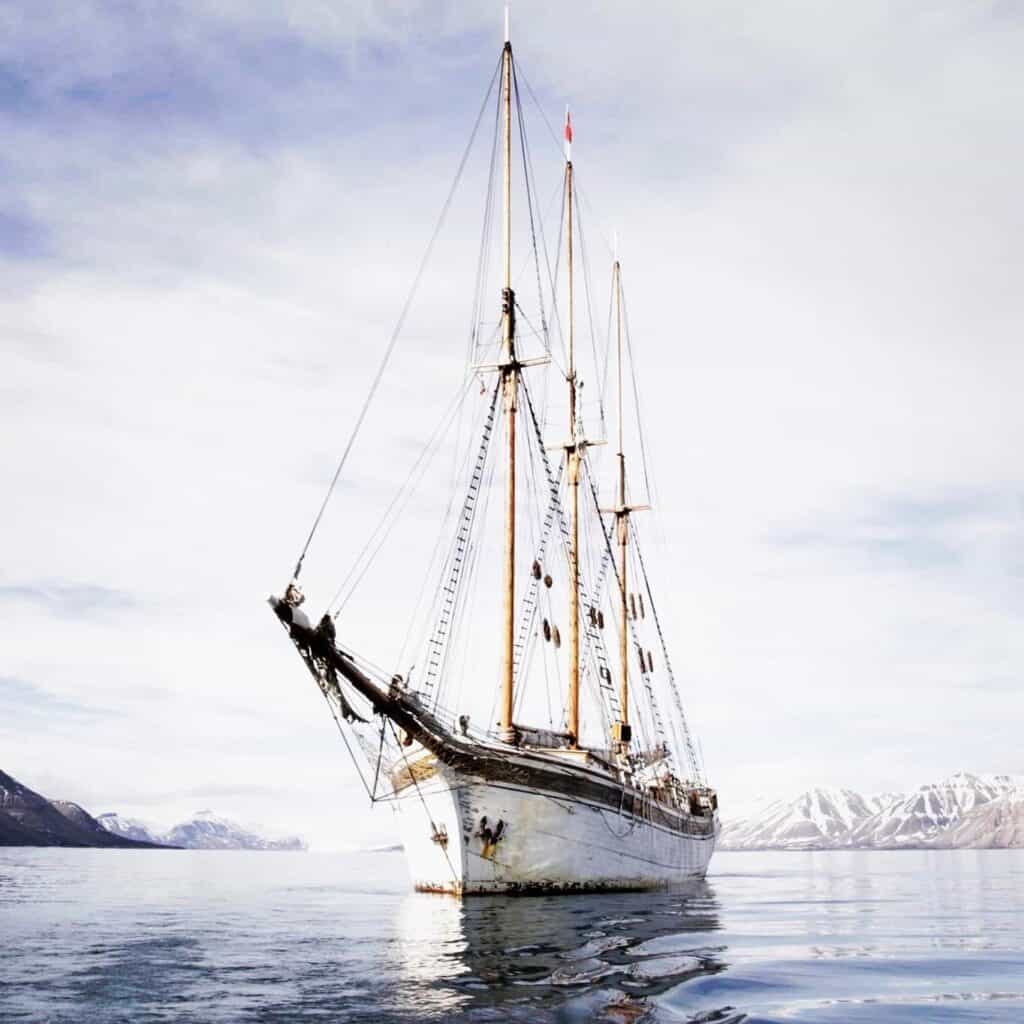
Aims of #Foundation Expedition
Led by renowned explorer Jim McNeill, there will also be scientists, naturalists and content creators on board for these voyages, as well as a number of citizen scientists. Those joining the expedition will be trained to sail and to contribute directly to the scientific endeavours.
The #Foundation Expedition aims was principally to install and test scientific and technological equipment such as weather stations, FerryBox, CTD and Bathymetry as well as Communications systems.
It proved useful in many other ways in terms of getting used to the ship and the opportunities it created, above the previous land and sea ice based expeditions with Ice Warrior Projects. Plymouth Marine Lab is one of many the Scientific partners looking forward to the ability to monitor this remote area for 10 years. They have been in the news in Nov 2023, as together with 40 other organisations they are pushing Governments at COP28 for more monitoring of the effects of climate change on the worlds oceans

Meet the Expedition Ship
3-masted schooner ‘Ocean Warrior #Resolute Expeditions ship Linden’ is a specialist in High Arctic sailing…
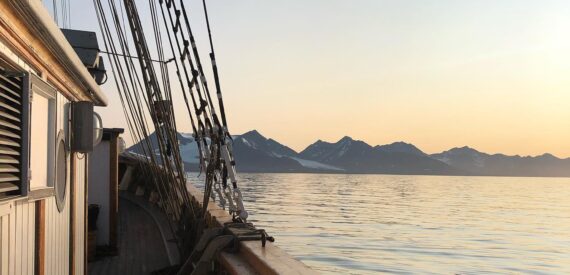
Destination Svalbard
Find out more about this fascinating archipelago…
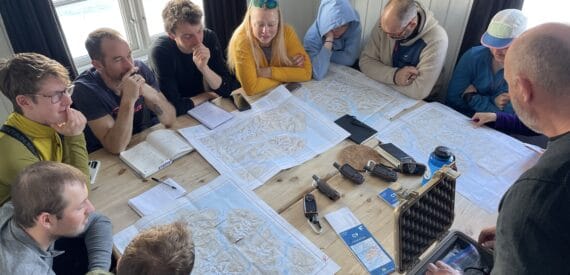
The Ocean Warrior Team
Meet the scientists, researchers and crew who’ll be on board…

OW Expedition FAQs
Feeling a bit adrift? Here are all the answers you need…

Jessie Atkinson
Colourblind sailor and jumped-up cook
Blog search
Latest Posts
02/28 Educational
2024 – Classic Sailing’s Year of Skills: Confident Crew
02/01 Boat building
2024: Classic Sailing’s Year of Skills! It’s not just sailing, you know!
01/14 Inspiration
Turning the Tide on Blue Monday
10/11 Climate Change
Science & Sailing: Ocean Warrior #Resolute Expeditions
03/16 Educational
Why I love the gig boats.
03/07 Book Reviews
Resilience & Wit in the 1890s
02/29 Ocean Warrior
Ocean Warrior – Transparency in Costs
Destination Svalbard: the ‘Cold Shore’
Ocean Warrior #Resolute Expeditions 2024 – 2033
More Stories
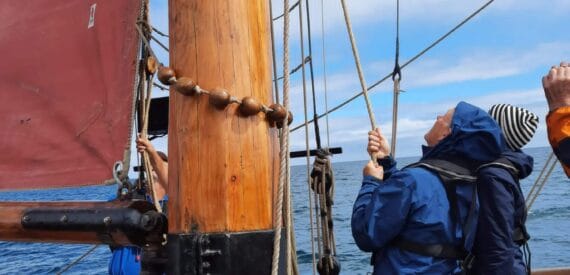
28/02 Educational
Throughout 2024, we’re shining the spotlight on the various ways our customers get more with a Classic Sailing booking. Sailing on a traditional vessel

01/02 Boat building
Throughout 2024, we’re shining the spotlight on the various ways our customers get more with a Classic Sailing booking. There are many physical and
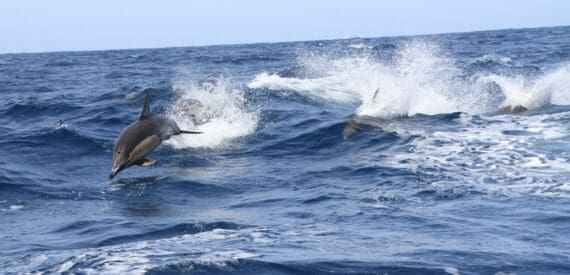
14/01 Inspiration
Turning the Tide on Blue Monday Blue Monday, marked on 15th January 2024, is here again. Many of us find ourselves caught in the

11/10 Climate Change
I couldn’t praise the Linden crew highly enough, extremely professional, friendly and encouraged us to be part of the team. I’d sail on that
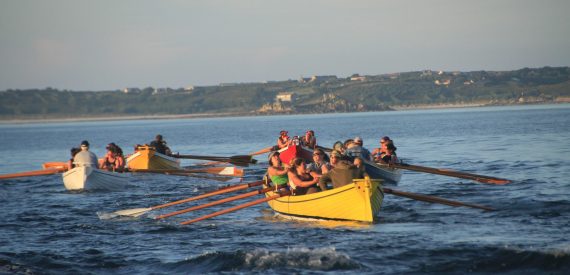
16/03 Educational
I grew up in St Mawes, Classic Sailing’s home base, and learnt to row in the harbour when I was about 7 years old
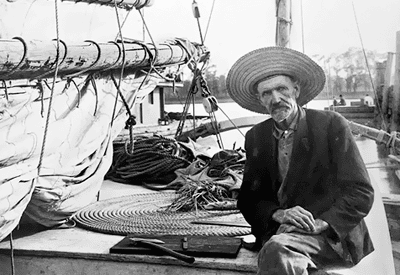
07/03 Book Reviews
Sailing Alone Around the World Joshua Slocum was the first man to circumnavigate the world solo, a feat he accomplished between 1895 and 1898
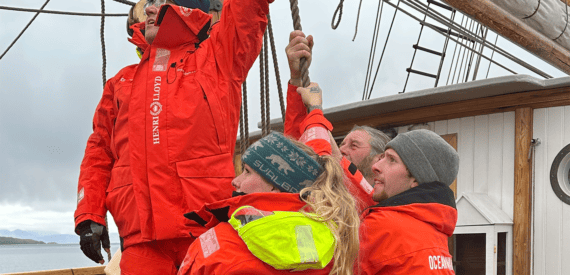
29/02 Ocean Warrior
TRANSPARENCY IN COSTS: A CLOSER LOOK In a world where honesty and integrity reign supreme, Ocean Warrior stands firm in its commitment to transparency.
Airfinity sponsors Team Ocean Warrior, the first ever Scandinavian boat to row across the Mid Pacific Ocean
We are proud to share that Airfinity is a proud sponsor of Team Ocean Warrior, the first ever Scandinavian boat to row across the Mid Pacific Ocean.
With a crew of just four (including Airfinity's very own Chairman J.P. Leschly Neergaard ), Team Ocean Warrior is taking on this challenge to generate awareness about the health of our oceans, fundraise for charity and outline the value of teamwork.
Team Ocean Warrior
Captain of the crew is Lasse Wulf Hansen, a veteran officer in the Danish Army and is one of the most experienced ocean rowers in the world, having rowed the Atlantic Ocean an impressive three times.
Andreas Dyrby is a former rower turned police officer and ultramarathon-runner, who brings grit, an uncanny lust for adventure, and a lot of horsepower to the crew. The team even has an Olympic rower on board, Joachim Sutton, who received a bronze medal in Tokyo 2021. The fourth and final member of the crew is JP Leschly Neergaard, a seasoned veteran (both in athletics and business) who will be contributing extensive leadership, calmness, and, of course, a solid sense of humour.
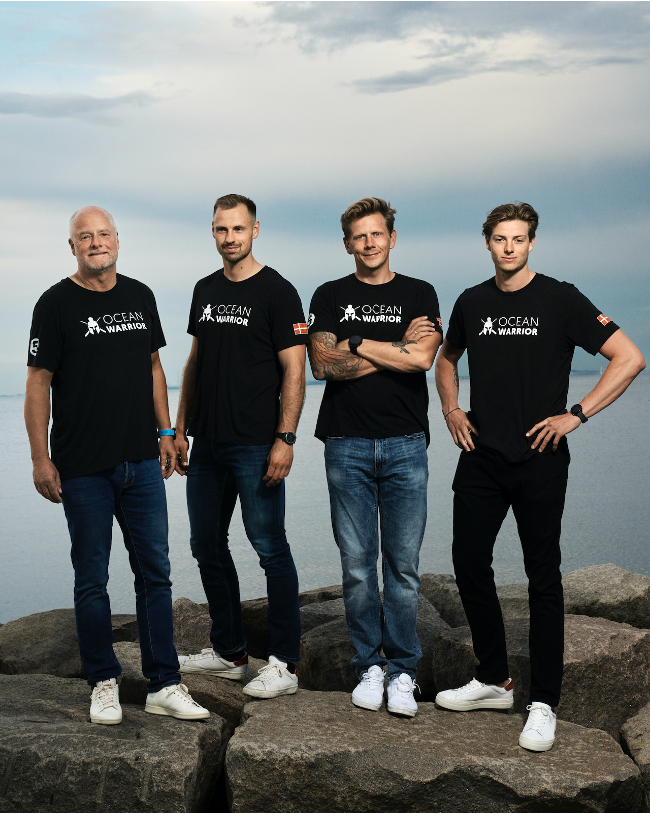
The Pacific Challenge wonderfully embodies what Airfinity represents; exceptional teamwork, complex problem solving, setting ambitious goals, and the commitment to finding solutions to some of the world's biggest challenges.
Learn more about Airfinity's here and if you're interested in joining our team, view our current open roles .
More Insights From Airfinity
Introducing airfinity biorisk: risk surveillance and analytics for 160+ infectious diseases, 18 million monkeypox vaccines needed to protect most at risk, 85 million to protect wider gay community and health workers, sales of covid-19 antiviral pill paxlovid to leap frog merck’s competitor molnupiravir, covid-19 vaccines sales to bounce back with new jabs taking a fifth of the 2022 market, astrazeneca and pfizer/biontech saved over 12 million lives in the first year of vaccination, global wastage of covid-19 vaccines could be 1.1 billion doses.
Men's Sailing
- Sailing Jackets
- Sailing Trousers
- Sailing Shorts
- Base layers
Women's Sailing
- Shell Jackets
- Emirates GBR SailGP
- Partnership
HENRI-LLOYD PARTNERS WITH BRITISH EXPLORER JIM MCNEILL AND THE OCEAN WARRIOR PROJECT TO SUPPORT VITAL RESEARCH ON ‘THE PULSE OF THE PLANET
Iconic performance brand Henri-Lloyd announces an exciting new partnership with British explorer Jim McNeill, who will represent the brand as a Global Ambassador through his role leading The Ocean Warrior Project.
Jim McNeill is one of the world’s most experienced and respected explorers and has clocked up over 38 years of expeditioning in the world's most remote and harshest environments. His life’s mission is to put a better finger on the “pulse of the planet” and to inspire ordinary people to do extraordinary things, in 2001 Jim conceived the ‘Ice Warrior’ Project and over two decades he has led 450 people across seven major expeditions, with their findings cited in many scientific papers and leading publications.
Launched as part of the not-for-profit, Global Warrior Project in 2023, Ocean Warrior is aiming to take 18 people on each of 8 legs of a 10,000 nautical mile, exploration to build a better understanding of the ocean’s tipping points through citizen science. The purpose is to collect critical ‘ground truthing’ scientific measurements to help deliver ‘the holy grail of oceanography’ and understand how much carbon is stored in our oceans, and how this is impacting on acidification, pollution, and species.
Henri-Lloyd will support The Ocean Warrior Project with protective and performance clothing during the expedition which starts from Svalbard, Norway in June 2023. The route will see the team head down to Plymouth, around Britain and north again to Iceland, South Greenland, West Greenland, Baffin Island, and finally to Resolute Bay, Canada, returning in October 2023, as they experience extreme temperatures below freezing, harsh winds and life at sea onboard Europe’s largest wooden Schooner, SV Linden.
Participants require no previous experience of sailing tall ships, but these aspiring explorers will need to show initiative, resilience, tenacity as well as an interest in the role as a citizen scientist. The project is looking for people from all backgrounds, as well as seeking up to 10 inner city would-be explorers drawn from unprivileged backgrounds, the 10 will be funded by the project, removing financial barriers to participation.
Henri-Lloyd’s founder Henri Strzelecki had a dream to protect those that dared to break the boundaries of exploration and adventure. He designed products that would protect in any condition, as well as allow people the freedom to perform without restrictions. This passion for protection led the way in a history of design firsts, from the introduction of the groundbreaking use of Bri-Nylon, the first non-corrosive zipper, the hand taping of seams as an alternative to varnishing, and the standard use of Velcro closures that remain industry standards to this day.
“Jim and The Ocean Warrior Project represent an opportunity for Henri-Lloyd to revisit our heritage, to step once again into the world of exploration, adventure, and support today’s modern pioneers. This partnership embodies values of purpose and sustainability that are at the core of our aims and objectives for the future Henri-Lloyd. We are excited to work with Jim on this unique project to support real people achieving incredible things alongside providing vital data that will help us all understand more about the oceans that support our planet.“ - Graham Allen, CEO Henri-Lloyd.
Jim McNeill, Explorer, and Henri-Lloyd Global Ambassador “My aim is to scientifically gauge and report on the condition of our Oceans which are crucial to life itself and share the experience of real exploration with individuals from all backgrounds. The #Resolute Expedition will cover a wide range of conditions, including temperatures down to -50 with wind chill, especially when dealing with ice on the deck. The Irminger Sea, on the southeast coast of Greenland is notoriously rough, and some of our crew will be novice sailors so the degree of protection and performance which Henri-Lloyd affords our crew is crucial. As a brand they bring over six decades of innovation and design, they were the original protective waterproof brand, developing ground-breaking solutions to protect the first ocean pioneers. Their commitment to responsible production means we know that the team will be protected to the highest standards in all conditions, wearing products made with a conscience for the planet and oceans we are working to protect.”
© ODLO WIND UK LIMITED 2024 . All rights reserved.
- Bahasa Indonesia
- Slovenščina
- Science & Tech
- Russian Kitchen
Cruising the Moskva River: A short guide to boat trips in Russia’s capital

There’s hardly a better way to absorb Moscow’s atmosphere than on a ship sailing up and down the Moskva River. While complicated ticketing, loud music and chilling winds might dampen the anticipated fun, this checklist will help you to enjoy the scenic views and not fall into common tourist traps.
How to find the right boat?
There are plenty of boats and selecting the right one might be challenging. The size of the boat should be your main criteria.
Plenty of small boats cruise the Moskva River, and the most vivid one is this yellow Lay’s-branded boat. Everyone who has ever visited Moscow probably has seen it.

This option might leave a passenger disembarking partially deaf as the merciless Russian pop music blasts onboard. A free spirit, however, will find partying on such a vessel to be an unforgettable and authentic experience that’s almost a metaphor for life in modern Russia: too loud, and sometimes too welcoming. Tickets start at $13 (800 rubles) per person.
Bigger boats offer smoother sailing and tend to attract foreign visitors because of their distinct Soviet aura. Indeed, many of the older vessels must have seen better days. They are still afloat, however, and getting aboard is a unique ‘cultural’ experience. Sometimes the crew might offer lunch or dinner to passengers, but this option must be purchased with the ticket. Here is one such option offering dinner for $24 (1,490 rubles).

If you want to travel in style, consider Flotilla Radisson. These large, modern vessels are quite posh, with a cozy restaurant and an attentive crew at your service. Even though the selection of wines and food is modest, these vessels are still much better than other boats.

Surprisingly, the luxurious boats are priced rather modestly, and a single ticket goes for $17-$32 (1,100-2,000 rubles); also expect a reasonable restaurant bill on top.
How to buy tickets?
Women holding photos of ships promise huge discounts to “the young and beautiful,” and give personal invitations for river tours. They sound and look nice, but there’s a small catch: their ticket prices are usually more than those purchased online.
“We bought tickets from street hawkers for 900 rubles each, only to later discover that the other passengers bought their tickets twice as cheap!” wrote (in Russian) a disappointed Rostislav on a travel company website.
Nevertheless, buying from street hawkers has one considerable advantage: they personally escort you to the vessel so that you don’t waste time looking for the boat on your own.

Prices start at $13 (800 rubles) for one ride, and for an additional $6.5 (400 rubles) you can purchase an unlimited number of tours on the same boat on any given day.
Flotilla Radisson has official ticket offices at Gorky Park and Hotel Ukraine, but they’re often sold out.
Buying online is an option that might save some cash. Websites such as this offer considerable discounts for tickets sold online. On a busy Friday night an online purchase might be the only chance to get a ticket on a Flotilla Radisson boat.
This website (in Russian) offers multiple options for short river cruises in and around the city center, including offbeat options such as ‘disco cruises’ and ‘children cruises.’ This other website sells tickets online, but doesn’t have an English version. The interface is intuitive, however.
Buying tickets online has its bad points, however. The most common is confusing which pier you should go to and missing your river tour.

“I once bought tickets online to save with the discount that the website offered,” said Igor Shvarkin from Moscow. “The pier was initially marked as ‘Park Kultury,’ but when I arrived it wasn’t easy to find my boat because there were too many there. My guests had to walk a considerable distance before I finally found the vessel that accepted my tickets purchased online,” said the man.
There are two main boarding piers in the city center: Hotel Ukraine and Park Kultury . Always take note of your particular berth when buying tickets online.
Where to sit onboard?
Even on a warm day, the headwind might be chilly for passengers on deck. Make sure you have warm clothes, or that the crew has blankets ready upon request.
The glass-encased hold makes the tour much more comfortable, but not at the expense of having an enjoyable experience.

Getting off the boat requires preparation as well. Ideally, you should be able to disembark on any pier along the way. In reality, passengers never know where the boat’s captain will make the next stop. Street hawkers often tell passengers in advance where they’ll be able to disembark. If you buy tickets online then you’ll have to research it yourself.
There’s a chance that the captain won’t make any stops at all and will take you back to where the tour began, which is the case with Flotilla Radisson. The safest option is to automatically expect that you’ll return to the pier where you started.
If using any of Russia Beyond's content, partly or in full, always provide an active hyperlink to the original material.
to our newsletter!
Get the week's best stories straight to your inbox
- What to do in Moscow City, if you’re not mega-rich
- Moscow after dusk: 10 places to drink, dance, and groove
- 5 things you must do in Moscow in 2018 between football matches (or without them)
- Sandwiched between Moscow and St. Petersburg: How to spend a perfect weekend in Tver
- 24 or 48 hours in Moscow: Where to go and what to do in 2019
This website uses cookies. Click here to find out more.
Green Point beach near Yamba littered with debris after abandoned boat runs aground
News ticker, bushfire warning.
An emergency warning is issued for McArthur River at Borroloola. Likely to peak Thursday afternoon. For the latest, search on ABC Emergency
A remote beach near Yamba on the New South Wales north coast is littered with debris and diesel after a boat ran aground and was smashed to pieces in the surf overnight.
Witnesses said the boat was abandoned by its occupants as they were attempting to cross the Clarence River bar around lunchtime on Monday.
NSW Road and Maritime said the occupants were evacuated from the vessel by a NSW Marine Rescue crew.
Angourie resident Oli Coe said he later saw the vessel adrift about 2 kilometres offshore.
He watched the boat throughout the day and at one point saw another vessel alongside it.
He said someone boarded vessel and put out its anchor.
"As the wind got up through the rest of the afternoon, we watched the boat drifting and dragging on its anchor and eventually it just dragged way too far and ended up on the beach," Mr Coe said.
At one stage Mr Coe and two friends used jetskis to get out to the boat to see if they could do anything to help.
He said he could not understand why it was not salvaged before it ran aground near Green Point.
"There was definitely some damage to the boat but it was in perfectly good condition [before that]," Mr Coe said.
Clean-up concerns
Locals spent Tuesday morning on the beach, dragging piles of debris above the high tide mark in a bid to ensure it is not taken back out to sea with the next high tide on Tuesday evening.
Angourie resident Kim Wood said the usually pristine beach at Green Point looked like a "rubbish dump".
"I'm looking at kilometres of debris," she said.
"There is timber, there is oil cans, jerry cans full of diesel, so much plastic, and everything is soaked in diesel.
"You can still see all debris in the ocean."
Ms Wood said the area was home to a wide range of birdlife including oyster catchers and curlews.
Too dangerous to tow
NSW Maritime said the boat was deemed too dangerous for authorities to board or tow.
Senior boating safety officer Bret Ryan said authorities needed to put safety first.
"Marine Rescue revisited the boat several times on Monday, and eventually the Water Police came from Coffs Harbour," Mr Ryan said.
"They came to the same conclusion that it was too dangerous."
"At that point the vessel was secure and the hope was it would remain in that position but unfortunately that didn't happen."
Mr Ryan said the main hazard on the beach was from any sharp objects that might remain buried in the sand.
ABC North Coast — local news in your inbox
- X (formerly Twitter)
Related Stories
Lone sailor, 70, winched to safety after yacht slams into 65m cliffs at flinders island.
Luxury Kimberley charter boat runs aground off coast ahead of tourist season
- Maritime Accidents and Incidents
- South Grafton

IMAGES
COMMENTS
Ocean Warrior Yacht for Sale is a 39 superyacht built by Pelin in 1993. Currently she is located in Picton and awaiting her new owners. Visiting From Europe? | SAVED YACHTS | ... With Ocean Warriors iconic, frugal and economical Gardner diesel and a fuel capacity of 2,500 litres, she is designed to meet the demands of fishing, diving, and ...
Our international fleet includes ten ships and several smaller boats used in various ocean conservation campaigns. Seahorse. Type Offshore supply vessel Launched 2000 Gross Tonnage 86 Length 150 ft ... Ocean Warrior. Type ...
July 25, 2016. Sea Shepherd/YouTube. Sea Shepherd's brand new anti-poaching boat slowly moved into the Antalya Harbour in Turkey on Friday, touching its first saltwater in what is sure to be a ...
The 1st er july 2016, Sea Shepherd launched its new patrol vessel, the Ocean Warrior. This is the first time that the NGO, which fights for the conservation of marine flora and fauna, has had a boat specifically designed for the needs of missions, particularly in the Antarctic. Typically, Sea Shepherd used to transform old ships (coastguards, fishing boats) into marine defence tools.
Neptune's Navy serves to protect and defend the world's oceans and marine wildlife. Since 1977, a number of vessels have served in the Sea Shepherd fleet to protect marine wildlife in direct-action campaigns around the world. Today our international fleet includes over a dozen ships and smaller boats used in various ocean conservation ...
Headlines: Sunseeker's Princess AVK completes sea trials, who made the top 10 largest yachts, where to adventure next with your yacht & sea shepherd's new v...
Article body copy. In the middle of the Indian Ocean in March 2018, a rusty fishing boat cut through the waves as a similarly sized but far-sleeker vessel called the Ocean Warrior followed in hot pursuit.. At 54 meters long and nine meters wide, the Ocean Warrior is equipped with four engines, long-range fuel tanks, a helicopter landing pad, and a water cannon capable of hosing its target with ...
Range. 1,125 nautical miles, at maximum speed [2] Aircraft carried. 1× MD 500 helicopter can be embarked. MY Ocean Warrior is a cutter -class vessel owned and operated by the Sea Shepherd Conservation Society as research/survey patrol vessel. She is used in their direct action campaigns against whaling and illegal fisheries activities.
Meet the Ocean Warrior's new small boat, thanks to the generous support of Aegis Charitable Trust!
Mar Casariego profers a wide smile as she invites us into her abode, the 54-m yacht Ocean Warrior, which she captains for the Netherlands based marine conservation group Sea Shepherd. The research and patrol vessel is currently docked at ONE°15 Marina Sentosa Cove for maintenance works. Being able to house yachts of up to 200ft makes makes the ...
The M/Y Ocean Warrior is Sea Shepherd's first custom-built ship, and the fastest in the fleet, reaching speeds over 25 knots. Technical Information. Type Patrol vessel; ... The vessel is a former French pilot boat that carries two small boats. Having been built for the Atlantic Ocean, the ship is capable of navigating the roughest seas ...
To launch the new boat, the ship's crane has been replaced with a davit - a state-of-the-art piece of kit, based on the very first launching mechanisms for small boats on ships. They are tried and tested to be able to work exactly as we need them to, and together with it and the small boat, the Ocean Warrior is now even more capable than ...
As Captain of Sea Shepherd's newest yacht in the fleet - which was funded by the Postcode Lottery and delivered last September - Adam has just arrived back from Operation Nemesis, Sea Shepherd's 11 th direct action whale defence campaign. The three-month mission against illegal Japanese hunts in the Antarctic Ocean was successful in ...
I couldn't praise the Linden crew highly enough, extremely professional, friendly and encouraged us to be part of the team. I'd sail on that boat with that crew anywhere. The experience was at times spiritual, life affirming. I can't recommend the experience highly enough. Andy M - Ocean Warrior #Foundation Expedition, 2023
A look at the world's second Largest virtual yacht, Ocean Warrior. [formerly the world's largest virtual yacht]This yacht was our first yacht launched. The w...
Ocean Warrior #Resolute Expeditions 2024 - 2033. Each year the #Resolute Expedition will set sail aboard schooner 'Linden' for a 10,000 nautical mile voyage through the Arctic. The total voyage will take 4 months annually, and is split into 8 legs:
I'd sail on that boat with that crew anywhere. The experience was at times spiritual, life affirming. I can't recommend the experience highly enough.' Andy M - Ocean Warrior #Foundation Expedition, 2023. Explore Ocean Warrior #Resolute Expeditions Voyages 2024 to 20233. Register Your Interest in Joining a Ocean Warrior #Resolute Expedition.
Over a dozen boats/teams will spend anywhere from 30 to 50 days rowing a staggering 2,800 miles of ocean, starting from Monterey Bay in California and ending at Kauai island in Hawaii. We are proud to share that Airfinity is a proud sponsor of Team Ocean Warrior, the first ever Scandinavian boat to row across the Mid Pacific Ocean.
VesselFinder is a FREE AIS vessel tracking web site. VesselFinder displays real time ship positions and marine traffic detected by global AIS network.
Launched as part of the not-for-profit, Global Warrior Project in 2023, Ocean Warrior is aiming to take 18 people on each of 8 legs of a 10,000 nautical mile, exploration to build a better understanding of the ocean's tipping points through citizen science. The purpose is to collect critical 'ground truthing' scientific measurements to ...
Surprisingly, the luxurious boats are priced rather modestly, and a single ticket goes for $17-$32 (1,100-2,000 rubles); also expect a reasonable restaurant bill on top. How to buy tickets? Women ...
On this map you can see the details of the longest and most classic of the Flotilla Radisson boat tours: 2. Companies that do boat tours on the Moskva River. There are many companies that do cruises on the Moskva River, but the 4 main ones are: Capital River Boat Tour Company (CCK) Mosflot. Flotilla Radisson.
Walking tour around Moscow-City.Thanks for watching!MY GEAR THAT I USEMinimalist Handheld SetupiPhone 11 128GB https://amzn.to/3zfqbboMic for Street https://...
In short: An abandoned boat has been smashed to pieces by the surf after running aground at Green Point near Yamba in northern NSW. The ABC has been told the occupants made their way safely to ...